scaffmag
ISSUE 22, 2024
SCAFFMAG.COM
THE SCAFFOLDING MAGAZINE
SCAFFOLDERS’ QUARTERLY

ISSUE 22, 2024
SCAFFMAG.COM
SCAFFOLDERS’ QUARTERLY
ScaffChamp 2024 - A behind-thescenes look at the ultimate scaffolding showdown
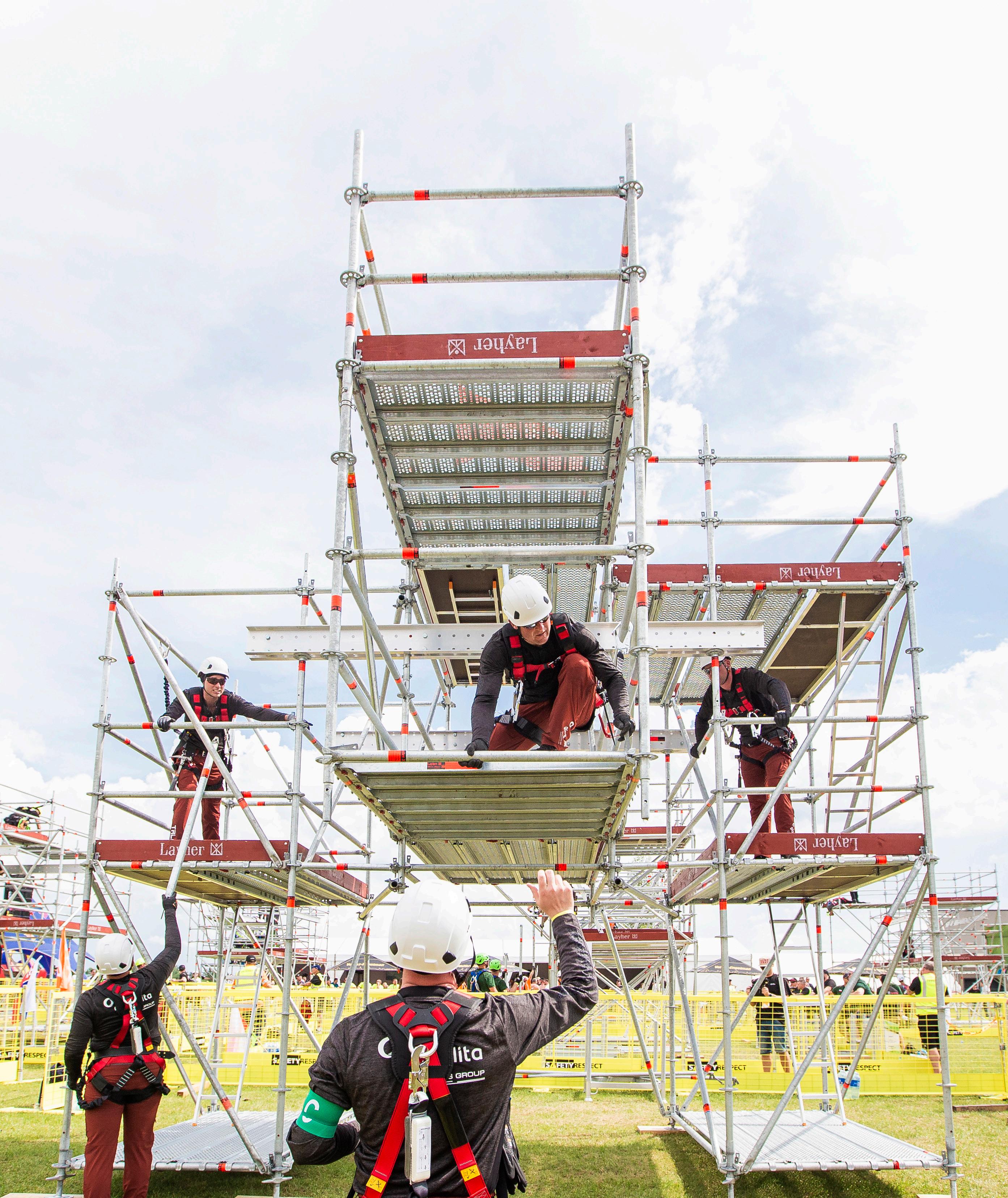
THE PEOPLE’S CHAMPIONS
EXCLUSIVE IN-DEPTH INTERVIEW WITH SCAFFCHAMP FOUNDERS VIKTOR VORONCOV AND OLEG ABRAMOV

H E R E ’ S S T A N D A R D S . . . A N D T H E N T H E R E ’ S








Industrial Services is a trailblazing company looking to provide a pathway for fresh talent.
30 People
Scaffolding contract manager by day, author by night; John McNicoll explains the balance between his day job and his passion for football writing.
32 From Scaffolding to Stardom
A look at some famous faces whose rise to stardom began on the building sites.
37 Business Spotlight
George Roberts (North West) has announced the formation of an Employee Ownership Trust to ensure future success through employee engagement and commitment.
44 Business
Industry giant Des Moore explains how to ensure that your business is as
A look at Pilosio’s Flydeck system in use; Sheffield’s former Henderson’s Relish factory is being repurposed and much more. 17 22 48
strong and resilient as possible in these uncertain economic times
48 Opinion
Michael Egan, Millcroft’s Senior Design Engineer, takes a look at the evolution of scaffolding design.
53 Products
Brent Scaffold Boards has partnered with fire-retardent boards specialists FireWright; KEWAZO’s cutting-edge LIFTBOT system is helping to transform the industry.
61 System
A roof upgrade for the National Bank in Belfast posed unique challenges for PERI and K2 Scaffolding.
68 Projects
Providing cost efficient, reliable scaffold and access solutions globally.


Providing total scaffolding management for projects of all sizes all over the world, giving the client everything they need f rom inception to completion.
OUR SERVICES
• Suppliers of all scaffolding and access products
• Scaffold design and drawings
• Scaffold calculations • Scaffold support
• Access consultancy • Scaffold training
• Quality assurance services
• Provision of scaffolding personnel
Proud to have worked in
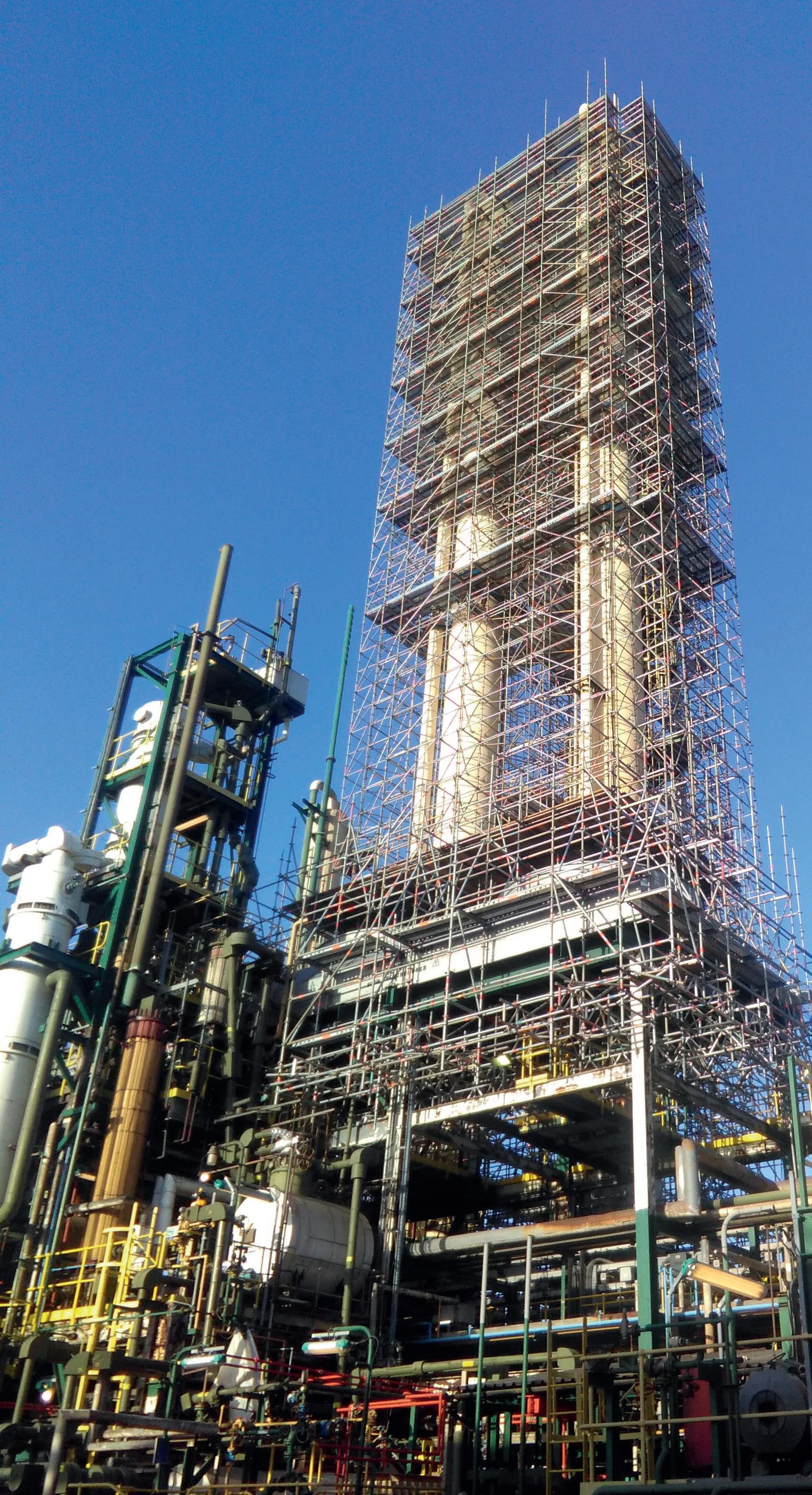
WWSA is a proud supporter of the

Worldwide Scaffold and Access Ltd
+44 (0) 1553 674044
+44 (0) 7796 445405
sales@wwsa co uk
www.wwsa.co.uk

As summer finally arrives, we are thrilled to bring you another jam-packed edition of ScaffMag highlighting the scaffolding industry’s vibrancy and dynamism. This season, we delve into some of the most captivating stories and developments that will inspire and inform you.
Our cover story takes a deep dive into ScaffChamp 2024, an event that has truly set a new standard in the scaffolding world. Held in the beautiful city of Vilnius, Lithuania, this fourth annual international scaffolding championship exceeded all expectations, showcasing exceptional scaffolding talent and innovation. Read the story on page 17.
Following this, we have an exclusive interview (on page 22) that you won’t want to miss. I sat down with Viktor Voroncov, the founder of ScaffChamp, and Oleg Abramov, Head of Operations. Together, they share this groundbreaking event’s remarkable journey and vision.
Meanwhile, in ‘From Scaffolding to Stardom’, we celebrate individuals who have journeyed from the scaffolding industry to achieving fame in many diverse fields. Their stories are inspiring and a testament to our community’s diverse potential (on page 32).
In this ScaffMag issue, our Business Spotlight (on page 37) shines brightly on George Roberts (North West) Limited. Since its inception in 1992, this company has grown from a local business to an industry leader, known for its commitment to quality and exceptional service standards. Under the leadership of Chairman George Roberts, the company continues to thrive and expand.
Our regular contributor and industry expert, Des Moore, provides invaluable insights in ‘Building a Stable Scaffolding Business’. This piece is particularly relevant for those navigating the challenges of running a scaffolding enterprise in volatile economic times (on page 44).
In ‘A Design for Heights’, (on page 48), we explore the fascinating evolution of scaffolding design. Millcroft’s Senior Design Engineer, Michael Egan, discusses and guides us on how advanced modelling technologies have revolutionised the industry, enhancing accuracy, safety and efficiency. Additionally, in this issue we bring you the latest in products and equipment alongside detailed project reports, ensuring you stay informed about the cutting-edge developments shaping our industry.
Thank you for being a part of the ScaffMag community. We hope you enjoy this summer issue as much as we enjoyed creating it for you. Here’s to a season filled with innovation, growth and sunny skies!
Happy reading and stay safe!
Daniel Norton – Editor dan@scaffmag.com
EDITORIAL
Editor Daniel Norton
T 01472 476024
M 07776 218831
E dan@scaffmag.com @ScaffMagDan
Features writers
Grahame Anderson
Richard Trenchard
Design
Demot Rushe Dermotrushe.co.uk
CONTRIBUTORS
Billy Jones - Millcroft
Scaffolding
Des Moore - MOR1X
ADVERTISING
Manager Jessica Norton
T 01472 476024
M 07776 218831
E jess@scaffmag.com
PUBLISHED BY
ScaffMag Ltd Office G8
The Enterprise Village
Prince Albert Gardens
Grimsby DN31 3AT
facebook.com/scaffmag
twitter.com/ScaffoldingNews
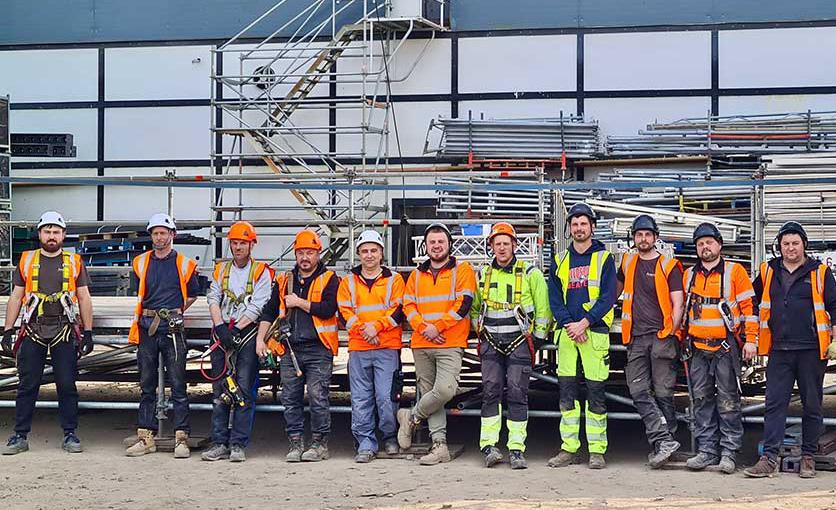
Acorn Structures is reaffirming its dedication to elevating event site safety standards by collaborating with the Event Structures Industry Training Scheme (ESITS) to provide extensive training and accreditation for its employees
❖ This initiative comes ahead of the 2024 festival, concert, summer sports, and outdoor event season, highlighting Acorn’s proactive approach to industry safety.
ESITS was established to address a significant gap in specialised training for professionals working within the event industry. Existing scaffolder qualification schemes fall short in covering the diverse skills required for Temporary Demountable Structures (TDS) used across various event sites. Acorn took the lead in committing to ESITS by enrolling its employees in comprehensive training and qualification programs.
In early 2023, Acorn conducted the inaugural one-day General Event Crew Operative (GECO) course, followed by the intensive 10-day Temporary Demountable Structures trainee course,
❖ The National Access and Scaffolding Confederation (NASC) has announced a pioneering initiative designed to bridge the critical skills gap in the UK’s thriving scaffolding and access sector.
This innovative Talent Solution aims to connect young professionals with reputable employers, addressing the urgent need for skilled talent in this rapidly expanding industry.
With the demand for top-tier scaffolding services on the rise, thousands of scaffolding contracting businesses are struggling to recruit young talent to meet industry needs. Recognising this pressing issue, NASC has developed a comprehensive platform to streamline the recruitment process and promote the diverse opportunities within the sector.
The NASC Talent Solution provides a user-friendly interface for candidates to register and connect with quality employers actively seeking skilled and enthusiastic individuals. By leveraging strategic partnerships with leading job
and concluded with the TDS Technician (Staging) Assessed Route of Entry.
Recently, Acorn furthered its support by piloting the 10-day Temporary Demountable Structures Technician course, a key part of their 2024 training investment program.
Acorn’s commitment to improving site safety is driven by Co-founder and CEO Andy Nutter and Technical Director Igor Pacejs, who have collaborated closely with SIMIAN to develop the ESITS qualification.
Their efforts were supported by HR and Payroll Manager Becky Williamson and Construction and Event Manager Craig Morland, who played vital roles in coordinating training administration. The ESITS accreditation process is overseen by a Board of Governors, Training Committee, and Industry

portals and utilising targeted social media and digital advertising campaigns, NASC ensures maximum visibility and reach for both candidates and employers.
Henry Annafi, NASC’s Training and Careers Manager, expressed his excitement about the initiative. “Our new Talent Solution represents a significant step forward in addressing the skills gap within the scaffolding and access sector. By providing a streamlined platform for talent acquisition and promotion, we aim to attract the brightest minds and nurture a new generation of skilled professionals,” Annafi said.
A standout feature of the NASC Talent Solution is the exclusive access granted to NASC members. These members can benefit from a comprehensive Talent Pack, which includes display materials and interactive equipment designed to showcase the exciting and diverse opportunities within the scaffolding
Interest Group, ensuring the scheme’s relevance and quality.
“We have been working with Simian for almost 20 years,” stated Andy Nutter from Acorn’s Head Office near Leeds, where the company’s training takes place. “We jointly developed System Scaffold training with CISRS, which was then adopted by the NASC and the construction industry. I hope the events industry will join Acorn and other early adopters like IPS and Actavo in supporting ESITS qualifications to ensure improved site safety in the temporary event structures sector,” he added.
Mike Dean, ESITS Scheme Director, expressed enthusiasm for the ongoing partnership with Acorn: “At ESITS, we are thrilled to work with Acorn Events on their mission to upskill their
and access sector. The Talent Pack aims to inspire and educate aspiring candidates about the rewarding career prospects available.
It’s worth noting that scaffolders and access operatives are highly trained professionals who often command salaries exceeding £50,000 per annum. With ample opportunities for career growth and advancement, the sector offers competitive remuneration packages and a supportive working environment, with many skilled individuals advancing into management and engineering design roles.
NASC’s Talent Solution is set to revolutionise the recruitment landscape within the scaffolding and access industry. By bridging the gap between talent supply and industry demand, the initiative fosters a culture of excellence and innovation.
For more information about the NASC Talent Solution and how to get involved, please visit www.scaffoldingcareers.com
WE ARE THRILLED TO WORK WITH ACORN EVENTS ON THEIR MISSION TO UPSKILL THEIR WORKFORCE AND RAISE COMPETENCY STANDARDS ACROSS THE EVENTS INDUSTRY
workforce and raise competency standards across the events industry. By providing comprehensive training programs and certifications, we can equip event professionals with the knowledge and skills necessary to deliver exceptional experiences.
Together, we are committed to driving innovation, professionalism, and excellence in Temporary Demountable Structures.”
In a significant development within the construction access industry, Brogan Group has announced the acquisition of Construction Access Systems (CAS), securing 100% of its shares
❖ Founded in 2010, CAS has distinguished itself as the foremost designer and manufacturer of the innovative Common Tower system utilised globally in high-rise construction projects.
The Common Tower system, a pioneering solution developed by CAS, allows multiple hoists to be arranged around a central access tower. This reduces the need for extensive cladding and provides a central point for vertical access, including integrated staircases. This system has been successfully implemented in landmark projects such as the One Park Drive Tower in Canary Wharf, London, the One Za’abeel Tower in Dubai, and the One Sydney Harbour Towers in Australia.
Brogan Group first used the Common Tower with their STROS 4050 Colossus Hoist on the £150 million Madison Amory Tower project in Canary Wharf in 2018. This project went on to win the Tall Buildings Award for ‘Best Residential Tall Building Project’ in 2022. Since then, Brogan Group has utilised Common Towers in numerous highprofile projects, including Battersea Power Station, Canada Water’s The Founding, Greenwich Peninsula, and multiple towers at Canary Wharf.
Tony Faulkner, the founding director of CAS, will join Brogan Group in a global sales role, aiming to expand international sales and further promote the Common Tower system for high-rise
buildings and new applications such as street gantries, loading bays, and docks.
“When we decided to sell CAS, we received significant interest from various parties, including hoist manufacturers and specialist access providers,” Faulkner commented. “Brogan Group emerged

early as the best fit to promote our Common Tower to a wider market both in the UK and internationally.”
Brogan Group, already a leading access company operating in the UK, Ireland, Dubai, Saudi Arabia, and expanding into new markets in Europe and the United States, believes that acquiring CAS will enhance its brand by adding the manufacture of the Common Tower system to its contracting and hire offerings.
Wayne Smith, a representative of Brogan Group, stated, “We see the demand for the Common Tower increasing worldwide. By adding manufacturing capabilities, we will significantly boost our appeal to new users and applications. The CAS system, being alloy, is lightweight and easy to pre-fabricate at ground level before lifting into position. Its inherent loadbearing capacity can service building heights exceeding 500 metres.”
The acquisition aligns with Brogan Group’s strategy to expand its range of access solutions, including hoists, scaffolding, mast climbers, crane decks, and cradles. The group is actively seeking further acquisitions and international partnerships in specialist high-rise access sectors, including construction hoists and related industries such as wind power and access platforms.

The Construction Industry Scaffolders Record Scheme (CISRS) is set to introduce an alternative innovative online Health, Safety, and Environment (HSE) test for scaffolding operatives in collaboration with the National Open College Network (NOCN)

❖ ScaffMag can reveal that this new test will launch in June marking a significant shift in how scaffolding professionals can achieve industry-recognised health and safety qualifications.
The upcoming test, designed in line with other recognised exemptions, will cover essential aspects of health, safety, and environmental practices required for obtaining a CISRS card. This card is a crucial credential for operatives in the scaffolding sector, ensuring they meet industry standards.
One of the standout features of this new test is its high-quality, neurodiverse eLearning content, which comes with an accompanying voice-over. This allows operatives to study and prepare for the test entirely online, eliminating the need for separate revision materials.
The comprehensive package of eLearning modules and the test itself will be available for a combined cost of £22.
David Brown, President of the National Access and Scaffolding Confederation (NASC) and IBN Scaffold Access Ltd, praised the new initiative. “I think this is a real win for the scaffolding sector,” Brown said.
“The operatives can now achieve an industry-recognised H&S test on their own terms. The flexibility it
offers by being online means people can learn at their own pace, whenever and wherever is convenient. It obviously removes the need to travel to a test centre. This is a very positive move; the sooner it goes live, the better.”
Dave Mosley, Managing Director of CISRS, also expressed optimism about the forthcoming test. “NOCN administers the CISRS card scheme on our behalf, so we have a very close working relationship with them. They previously introduced a very similar H&S test for the Plant sector, which has proven to be very popular.
We are confident that this can be equally successful for our sector and is something we look forward to exploring further in future.”
In preparation for the launch, CISRS and NOCN will conduct webinars and meet with CISRSapproved training providers and the wider scaffolding industry in the coming weeks.
The test is scheduled to go live on Monday, 18th June 2024. Further information on how to book the test will soon be available on the CISRS and NOCN websites.
This new development is expected to significantly enhance accessibility and convenience for scaffolding operatives, aligning with broader trends towards digital and flexible learning solutions in the construction industry.
❖ Gary Roser, a self-employed scaffolder from Hastings, was fined £750 with £643 in costs for working without a harness on a four-storey scaffold. His employer, Giant Scaffolding Ltd, was fined £15,000 plus £5,000 in costs. An HSE inspector spotted Roser balancing on scaffolding tubes 8 meters above the ground without fall protection. Despite having harnesses available, they were not used. Giant Scaffolding, previously warned about safety practices, failed to respond to HSE inquiries.
❖ Three scaffolders, Tony Calvert, Rob Freeman, and James McTaggart, heroically rescued a man from the rubble after a house exploded on Kirkland Walk, Park End, Middlesbrough. Witnessing the blast while working nearby, the trio rushed to the scene. Rob helped a neighbor out of the adjacent house, while Tony and James dug through debris to free the critically injured man. Emergency services evacuated surrounding homes, and an investigation into the explosion’s cause is underway. The rescued man was airlifted to the Royal Victoria Infirmary with severe burns.
❖ Stellar Scaffolding Ltd, led by Managing Director Joe Carr, is striving to become the UK’s top scaffolding company. Carr documents the company’s growth on YouTube, sharing the highs and lows of the business. In just two weeks, their transparent, documentary-style videos have garnered over 10,000 views. The series highlights securing contracts, operational challenges, and the company’s commitment to quality and safety. Carr’s goal is to achieve £20 million in annual turnover while building a legacy of trust. Follow their journey on the Stellar Scaffolding Ltd YouTube channel.




Tata Chemicals Europe Limited has been fined £1.125 million following the tragic death of Michael Densmore, a 37-year-old Scaffolder and father of four, who succumbed to injuries sustained while working at the company’s Lostock Hall site in Northwich
❖ The incident occurred on 30 November 2016, when Mr. Densmore, a scaffolder employed by Altrad NSG, was erecting a scaffold tower in the chemical plant. While stepping over a trough containing calcium hydroxide, heated to approximately 90 degrees Celsius, his foot slipped on an unfastened lid, leading to severe chemical and thermal burns.
Despite receiving specialist treatment and surgery at Whiston Hospital’s burns unit, Mr. Densmore tragically died at home on 3 January 2017, following a haemorrhage to his injured foot.
The Health and Safety Executive (HSE) investigation revealed significant lapses in safety protocols at the Tata Chemicals site. There was no permit for hazardous work, inadequate risk assessment, and insufficient warning signs about the dangerous conditions.
Crucially, Mr. Densmore had not been informed about the operational chemical troughs or the unfastened lids.
In a heartfelt statement, Mr. Densmore’s family described him as “a loving and amazing role model” and expressed their profound grief: “Our lives fell apart and have not been the same since that terrible day. Nobody should have to lose someone they love due to a workplace accident. The trauma we have all suffered as a family cannot truly be put into words.”
This incident is not the first safety breach for Tata Chemicals Europe, which has faced previous prosecutions related to health and safety failures. The company pleaded guilty to breaching Section 3(1) of the Health and Safety at Work etc. Act 1974 and was fined £1.125 million, along with an

NOBODY SHOULD HAVE TO LOSE SOMEONE THEY LOVE DUE TO A WORKPLACE ACCIDENT. THE TRAUMA WE HAVE ALL SUFFERED AS A FAMILY CANNOT TRULY BE PUT INTO WORDS
additional £60,603.54 in costs, at Chester Crown Court on 5 June 2024.
HSE Inspector Matt Lea emphasised the preventable nature of Mr. Densmore’s death, stating, “This tragic death could have been preventable had Michael Densmore and his colleagues been managed under a robust permit to work system for working in a live chemical plant containing corrosive chemicals heated almost to boiling point. Companies should learn the lessons from this incident and ensure robust safety measures are in place.”
The case was prosecuted by HSE enforcement lawyer Chloe Ward and supported by paralegal officer Sarah Thomas.
The Health and Safety Executive investigation revealed significant lapses in safety protocols at the Tata Chemicals site.

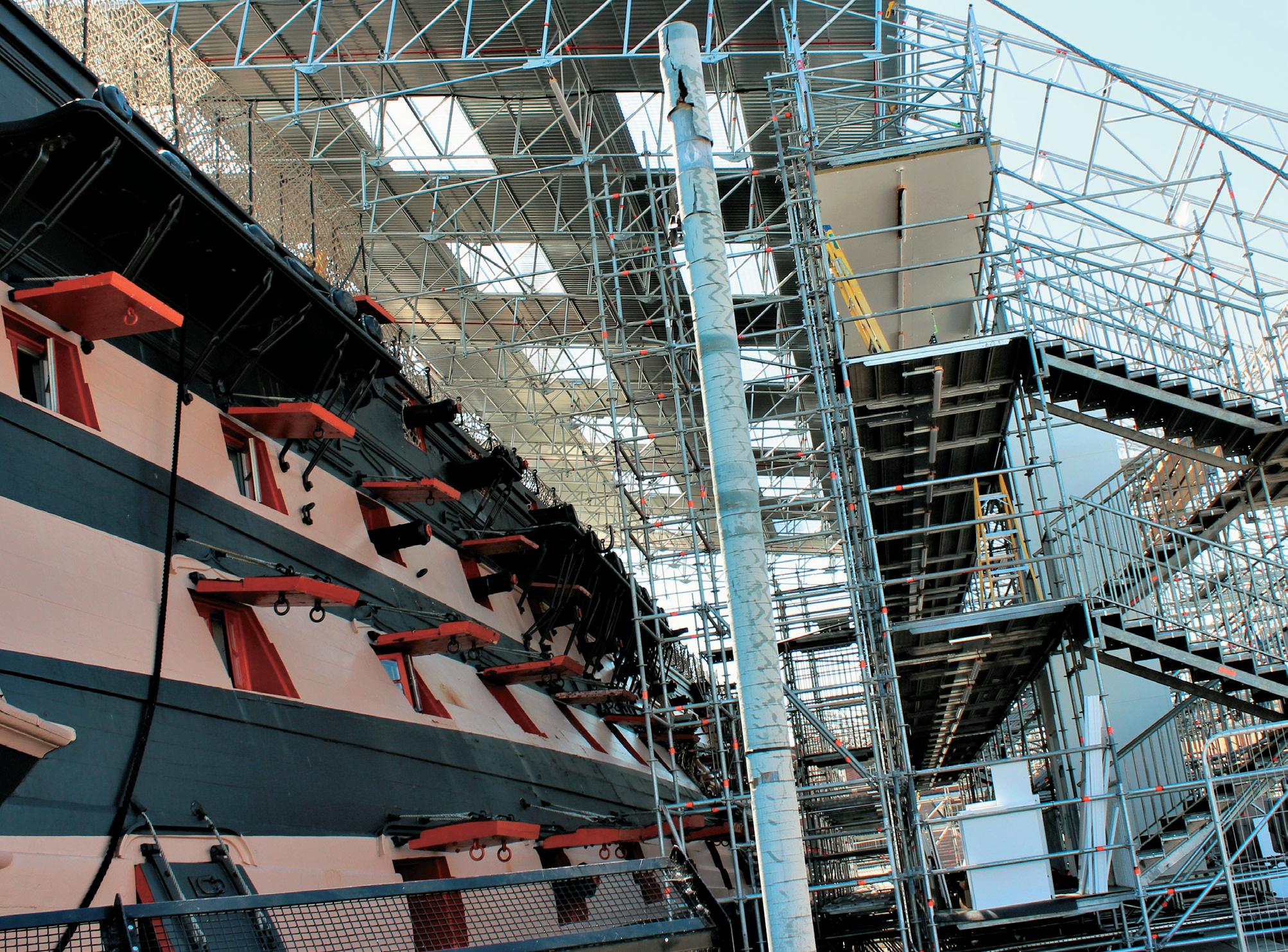
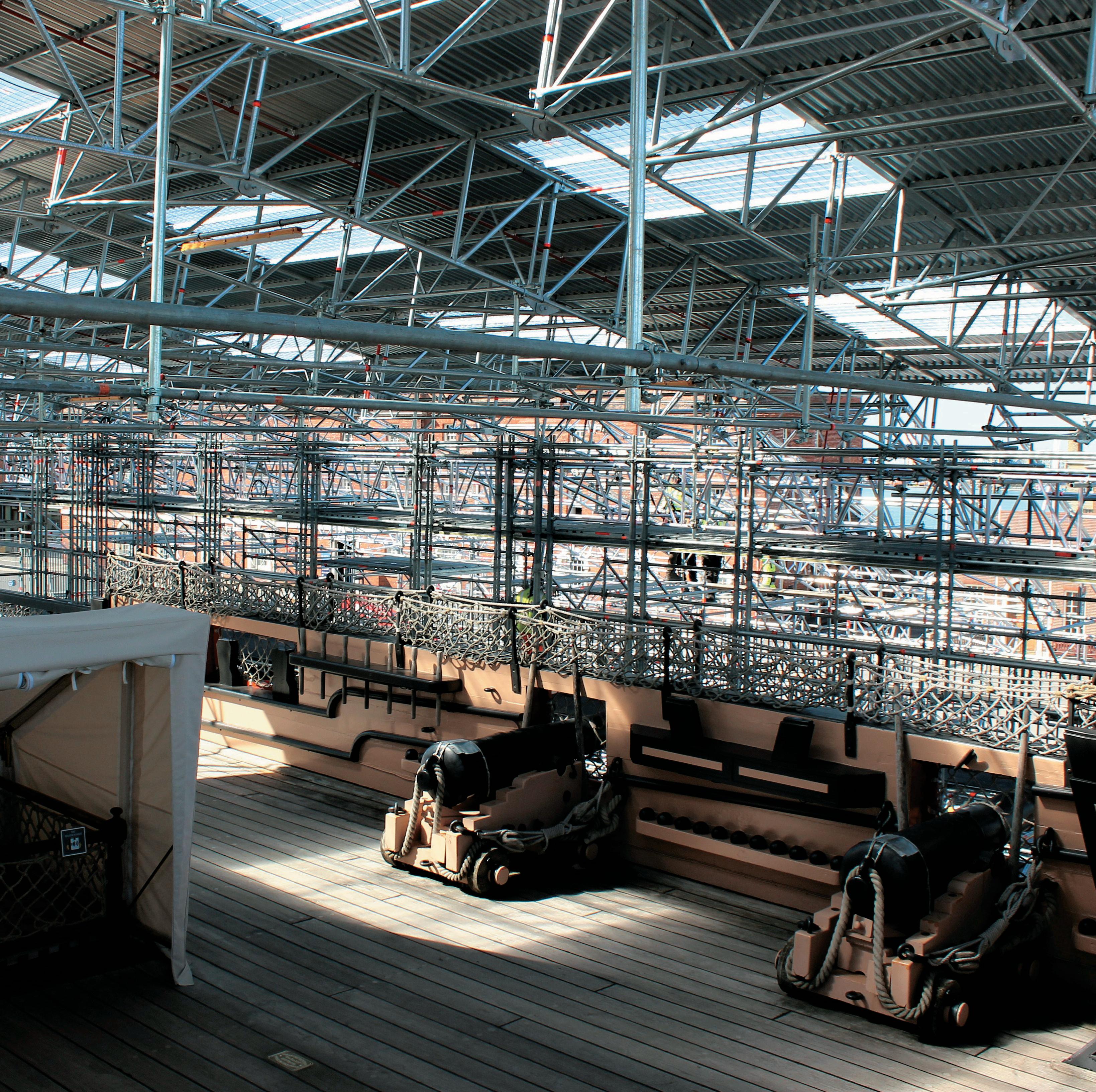


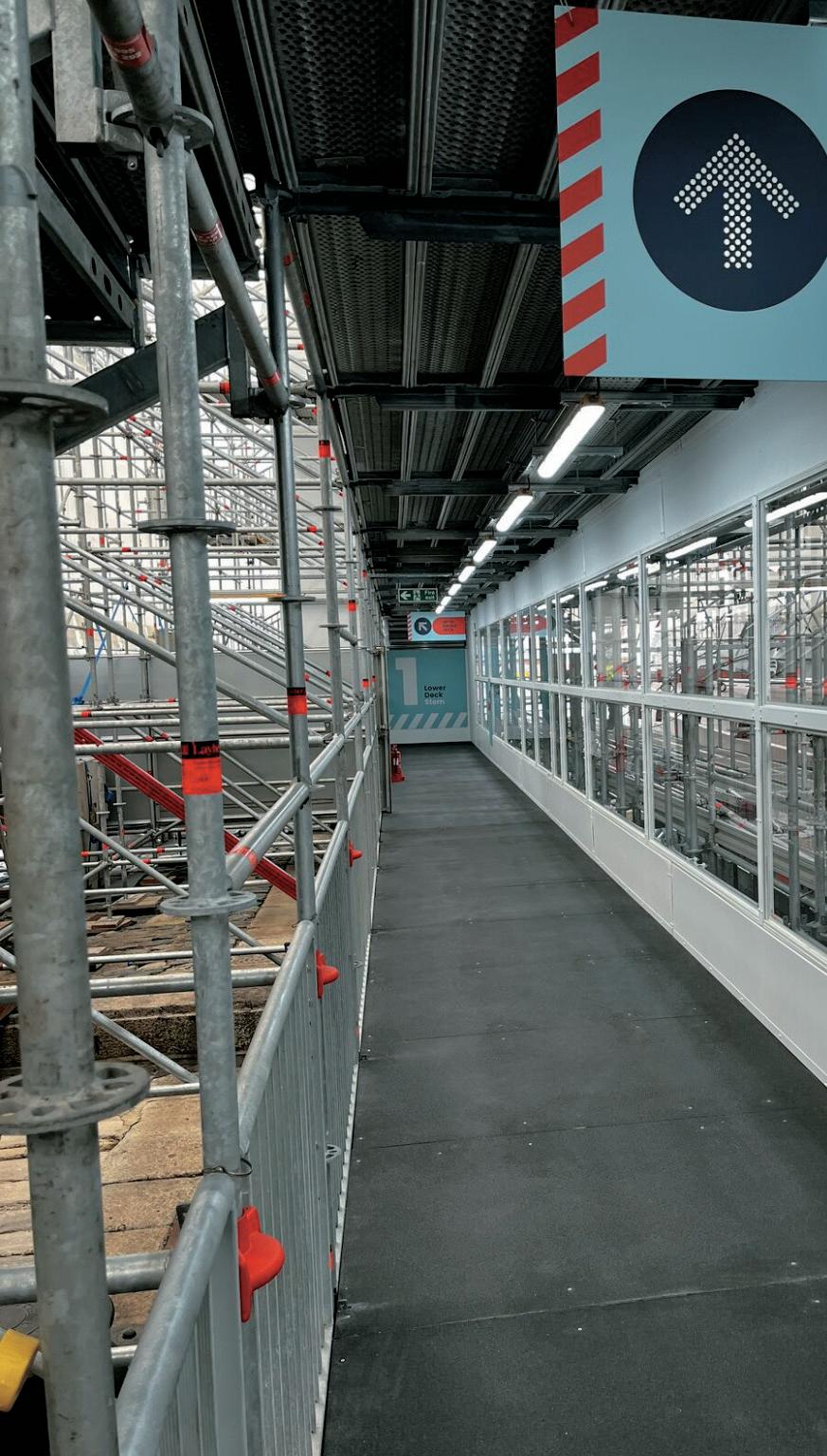
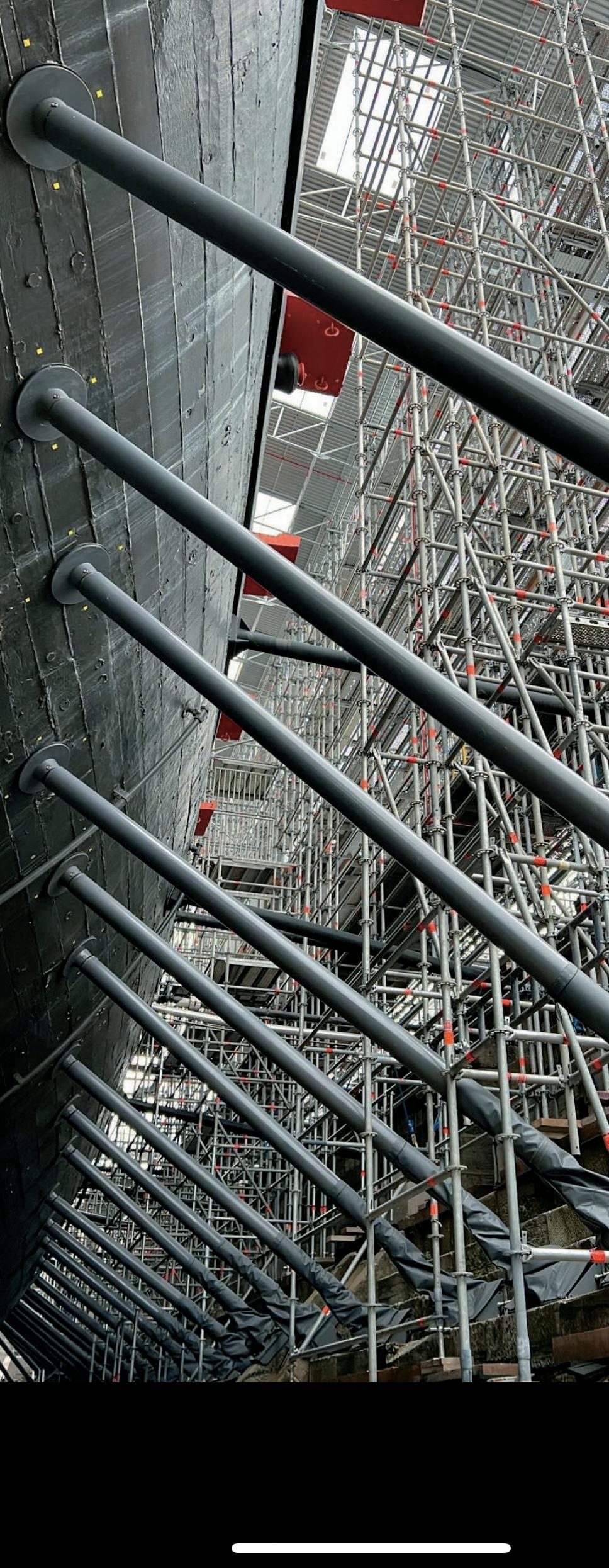
This November, all roads lead to Belfast for ScaffEx24, the groundbreaking event poised to revolutionise the scaffolding industry
❖ Set for November 29th, 2024, this conference, exhibition and awards ball will bring together the brightest minds and leading innovators in the field. With a stellar line-up of speakers and an agenda focused on opportunities, client relationships, innovation and training, ScaffEx24 is an unmissable event for industry professionals.

At the forefront of this extraordinary event is Suzannah Nichol, (left) the influential CEO of Build UK. Known for her transformative impact on the construction sector, Nichol will offer invaluable insights into what major clients seek from their scaffolding partners. Her talk will explore the Common Assessment Standard and shed light on the construction industry’s future.
Wayne Connolly, managing director of Connolly Scaffolding and incoming president of the NASC, joins the roster of industry heavyweights. Connolly’s innovative approaches and leadership in scaffolding promise to inspire attendees to strive for excellence in their field.

In an exclusive announcement to ScaffMag, ScaffEx24 revealed additional distinguished speakers who will also grace the event: Julio Black , Head of Product & Marketing at AT-PAC, is set to discuss cutting-edge innovations shaping the future of scaffolding. With over two decades of experience, Black’s insights into market analysis and product development will be invaluable.

Lee Rowswell, (left) Group Director of GKR Scaffolding, will highlight the sector’s vast opportunities, focusing on growth potential and career development.
Barry Neilson OBE, (right) Chief Executive of CITB NI, will address the critical importance of training and education in scaffolding, drawing from his extensive experience in enhancing workforce skills.
ScaffEx24 is not just about technical expertise, it also aims to inspire and energise. David Meade, a renowned speaker on human potential, and David Mosley, Managing Director of CISRS, will deliver sessions that provoke thought and encourage a forward-thinking mindset within the industry.
Marie Kaffour, Events Manager of ScaffEx24, captures the essence of the event: “ScaffEx24 aims to reshape the scaffolding industry. Our speaker lineup reflects our vision of highlighting opportunities, ‘meet-the-buyer’ strategies, innovation and training – the essential pillars that will drive the sector forward.”

In addition to the insightful conference sessions, attendees can look forward to the Winter Ball and Awards, promising a night of celebration and networking. Stay tuned as the exciting entertainment line-up will be announced shortly. Registration for this free-to-attend conference and expo is now open. Industry professionals at all levels are encouraged to stay informed and ahead of the curve by visiting the ScaffEx24 website, following their social media channels, and keeping an eye on ScaffMag for the latest updates. Mark your calendars for November 29th, 2024, and join us in Belfast for a transformative experience at ScaffEx24. For more information and to register, visit www.scaffex24.com.

The Scaffolding Association’s annual Scaffolding Conference (#scaffcon24) is gearing up for its third year with an exciting expansion.
❖ The 2024 event will now include an evening dinner dance complete with a live band and DJ, in addition to its popular industry-focused programme. This year’s conference finds a new home at the world-famous Belfry Hotel and Resort on Friday, 11th October 2024.
The Scaffolding Conference continues its tradition of providing a unique forum for leading experts and professionals in the scaffolding and access industry.
Keynote speakers and discussion panels will delve into key scaffolding
topics, offering practical insights to those working within the construction sector.
“We’re thrilled to expand ScaffCon24 following last year’s positive reception,” said Robert Candy, CEO of The Scaffolding Association.

“We want to empower those in the sector to stay ahead in this everchanging industry. Delegates at The Belfry will benefit from a carefully curated range of speakers and panellists offering insights to drive productivity, growth and success for scaffolding businesses. The dinner dance adds a fantastic social element to the event.”
Early bird savings are available for a limited time, with combined Conference and Dinner Dance tickets priced at £250 plus VAT.
To book or learn more, visit the event website at scaffoldconference. co.uk and follow #scaffcon24 on social media.
The scaffolding industry’s premier golfing event returns for its fourth year as SCP Forgeco announces the much-anticipated Scaff Open Tournament.
❖ Scheduled for 19 July 2024, the tournament will be held at The Astbury Golf and Lodge Resort in Bridgnorth, renowned as one of England’s finest 18-hole championship courses.
This immaculate venue, built to the highest USGA standards, promises a spectacular setting for this esteemed event.
The SCP annual golf tournament, complimentary for individuals working within the scaffolding industry, offers participants a unique opportunity to showcase their golfing prowess.
Coinciding with the same week as the British Open, the event highlights the growing popularity and competitive spirit of golf within the industry.
Since its inception, SCP Forgeco’s tournament has provided a remarkable platform for industry professionals to network and engage in a friendly yet competitive environment.
This year’s participants will vie for the prestigious ‘Scaff Open’ trophy, alongside various other prizes that will be awarded throughout the event.
“Are you the best golfer in the scaffolding industry? Time to prove it!” reads the challenge from SCP Forgeco, encouraging scaffolding professionals to seize this opportunity.
Interested participants are urged to register soon, as the company anticipates a high demand for spots. Registration is free but limited. More details and registration can be found at https://golf.scpgroup.uk
The SCP Group looks forward to welcoming all participants to the Astbury Golf and Lodge Resort on 19 July for a day filled with fun, camaraderie and competitive golf. Don’t miss your chance to compete for your very own Claret Jug and enjoy a day of top-tier golfing at this esteemed industry event.

















Following the tremendous success of last year’s ScaffChamp, the fourth annual international scaffolding championship, held in the Lithuanian capital, once again exceeded expectations and propelled the event to a brand-new level

This year’s mega event drew over 500 spectators from across the globe, with thousands more again tuning in via a live stream on YouTube, creating an inspiring atmosphere of industry camaraderie and fierce competition. With a big emphasis on safety this year, the family-friendly event also saw a number of families with children attending, enjoying the weather and the unique scaffolding spectacle. The kids also made use of the dedicated Kids’ Zone, which included an inflatable obstacle course, ensuring entertainment for all ages.
After months of detailed planning by the Baltic Scaffolding Association, the organisers of ScaffChamp, the competition kicked off early. In the heat of the Lithuanian sun, scaffolders raced to build their scaffolding structures as quickly as possible while adhering to strict safety rules based on the complex designs revealed the previous day.
These designs, crafted by the innovative scaffolding design software ScaffPlan, included Layher’s latest innovation, the Twix Beam, adding an extra layer of challenge and excitement for the competitors.
The 21 participating teams were split into three rounds throughout the day, with seven teams competing in each round. Each team was tasked with erecting the tricky and quite complex Layher scaffold against the clock. Once the first round of teams completed their build, they then had to dismantle their scaffolds before the next round could begin. This cycle repeated for each round, allowing all teams a fair and equal opportunity to showcase their skills.
Racing against the clock, teams demonstrated their craftsmanship, strategic planning, teamwork and scaffolding skills while referees watched them like hawks, marking them with time penalties for rule infringements or safety breaches.
“THE UK TEAMS PERFORMED AS WELL AS THEY COULD, GIVEN IT WAS THEIR FIRST TIME AT THE EVENT.”
The atmosphere was charged with focus and determination as teams from the UK, Finland, Hungary, Sweden, Lithuania and beyond showcased their expertise.
As the day progressed, the sun continued to shine brightly over Vilnius, creating an ideal setting for the spectators who had gathered to witness the unique scaffolding spectacle. Organisers reported that over 500 tickets were sold for the event, reflecting the increasing level of interest and enthusiasm from the scaffolding community.
However, as the final round ended, the weather dramatically turned in the late afternoon when the heavens unexpectedly opened, bringing a sudden downpour. The crowd and competitors quickly sought refuge in the main tent, where an impromptu party erupted, adding a memorable festival-like twist to the day’s proceedings. Music, beer, laughter and camaraderie filled the air as everyone waited for the final results.
The rainstorm, however, also led to some unforeseen challenges. Power problems emerged near the end of the day, causing a slight delay as referees worked diligently to tot up the results. Despite the chaos, the spirit of the event remained high, with participants and spectators alike embracing the unexpected turn of events with good humour and resilience.
Finally, after around an hour of anticipation, the referees completed their tally and announced the winners of ScaffChamp 2024. The atmosphere was electric as teams gathered to hear the results of their hard work and dedication over the past two days, which culminated in this moment.
N-Projects from Poland claimed the top spot, securing first place with their impressive build time of 71 minutes. Cumiskey Scaffolding from Ireland came in second with 83 minutes, while NBIK from Mongolia took third place with 85 minutes.
The UK teams performed as well as they could, given it was their first time at the event. They prioritised safety in all aspects of their builds but didn’t manage to secure top spots on the leaderboard.
Rose System Scaffolding Ltd finished joint fourth, Connect Scaffolding Ltd came ninth, and Star Scaffolding Ltd placed 20th. Despite not clinching the top positions, their performance was commendable,

Teams representing the UK, Finland, Hungary, Sweden, Poland, Lithuania and beyond took part in this year’s tournament.

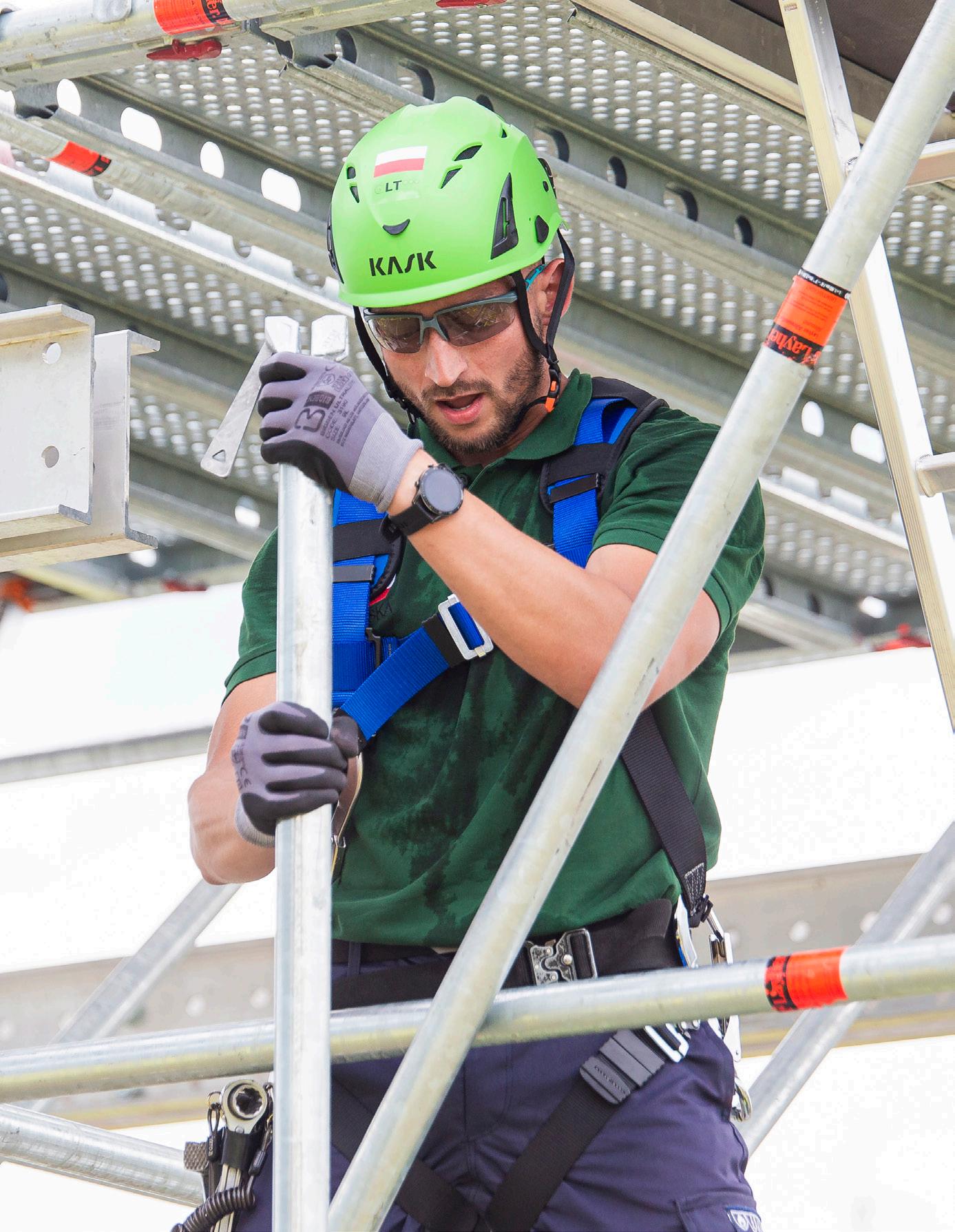
showcasing their potential and commitment to safety and quality.
The UK teams reflected on their first-time participation in ScaffChamp, sharing a mix of excitement, challenges and lessons learned. Chris Howson, Operations Director at Rose System Scaffolding Ltd, described the experience as “an excellent opportunity to go up against the best in Europe”. He emphasised the importance of teamwork and preparation, noting how his team studied the scaffold design the night before and observed other teams to refine their strategy.
Oliver Cave, Director at Connect Scaffolding Ltd, highlighted the intensity and enjoyment of the competition, stating, “It was an amazing experience. The team were nervous in the build-up, and it was pretty intense, but overall, they all really enjoyed it.” He also pointed out the strategic challenges, such as deciding whether to take penalties to save

ScaffChamp 2024 highlighted the importance of teamwork and preparation in an intense and enjoyable competition, and was hailed as a resounding success, bringing together the global scaffolding community in a vibrant display of talent and unity.


on build time. Lydia Stanton, Commercial Director at Star Scaffolding Ltd, expressed her excitement about participating in ScaffChamp for the first time. “Brilliant! The whole experience of exploring a new country, being part of the competition, and enjoying the competition as a team was wonderful.”
Lydia mentioned the challenge of going first in the competition, which she felt was a disadvantage: “Going first in the competition made a huge difference. Each round saw a decrease in time, which felt unfair.”
All three directors highlighted the strong sense of camaraderie and teamwork among their members. Chris remarked, “Watching them from the side, they all just seemed to know what the other was doing and kept a cool head.” Lydia echoed this sentiment, praising her team for pushing each other to do their best and noting, “They are friends, not just work colleagues.”
Reflecting on the overall experience, the UK teams shared positive feedback and lessons learned.


Oliver noted, “It was great to see how much scaffolding is loved across the world. It’s the people that make it such a great industry to be part of.” Lydia added, “Just take the opportunity. Overall, we had a great time.”
In addition to the main competition, several special awards were presented at the end of the event, recognising exceptional performance, dedication to safety, and overall contribution to the scaffolding community:
Simian international health and safety awards:
• Telinetiimi (Finland)
• Cumiskey Scaffolding (Ireland)
• N-Projects (Poland)
Leach’s (BigBen) MVP Awards:
• N-Projects (Poland)
• NBIK (Mongolia)
• Team Connect (UK)
Be ReMarkable Award:
• NBIK (Mongolia)
ScaffPlan Award:
• Rose System Scaffolding
The winners and all participants were celebrated with cheers and applause, their achievements a testament to their skill, precision and teamwork.
Despite its chaotic conclusion, the event was hailed as a resounding success, bringing together the global scaffolding community in a vibrant display of talent and unity.
As ScaffChamp 2024 came to a close, organisers and participants reflected on an unforgettable experience. The heightened emphasis on safety, the innovative complex designs, and the unexpected rainstorm all contributed to making this year’s event unique and memorable.
REFLECTIONS AND FUTURE
Oleg Abramov, Head of ScaffChamp Operations, praised the teams for their adaptability and resilience. “Watching teams adapt and thrive in challenging conditions was truly inspiring. This event continues to foster a sense of global community and professional excellence.”
“THIS EVENT CONTINUES TO FOSTER A SENSE OF GLOBAL COMMUNITY AND PROFESSIONAL EXCELLENCE.”
He added, “We achieved impressive results this year. We managed to attract many people from the scaffolding industry to one place. The feedback from the teams is helping us improve this event. In 2022, we had six teams, and in 2024, we had 21 teams. This incredible growth showcases the dedication and passion within our industry. It’s inspiring to see so many professionals come together to share knowledge, skills and camaraderie.
“I would like to thank all the participating teams; without them, we can’t imagine this event – they are the driving force behind it. Even though we are still in the early stages of organising ScaffChamp, with this being only our second major event, we will work hard to fix any mistakes and make improvements for next year.
“We look forward to building on this success and making future events even better.”
Mark Parkin, ScaffChamp Referee Supervisor, added: “ScaffChamp 2024 was an unforgettable spectacle, where Lithuania played host to a thrilling blend of sunshine and hailstones, culminating in a breathtaking finale. The competitionhas grown exponentially each year, and 2024 was no exception, with intense rivalries and newfound friendships shaping the event’s vibrant atmosphere. Networking opportunities abounded, forging enduring relationships that will drive the industry forward.
“As I reflect on the invaluable experiences and lessons learned, our resolve to return stronger in 2025 is unwavering. Celebrating its milestone fifth year, ScaffChamp promises to deliver even more excitement and innovation, setting new benchmarks in the world of scaffolding competitions. The journey continues, and the best is yet to come.”
The success of ScaffChamp 2024 underscores the growing recognition of scaffolding as a skilled profession and its central role in global construction. As the event continues to grow each year, it not only elevates the level of competition but also cements the bonds of this unique international community.

ScaffMag’s Editor, Daniel Norton, had the opportunity to speak with Viktor Voroncov, the visionary founder of ScaffChamp, and Oleg Abramov, the Head of ScaffChamp Operations, to delve into the origins, evolution and future of this remarkable event
Since its inception in 2019, ScaffChamp has rapidly grown into a premier international scaffolding championship, drawing competitors and spectators from around the globe. As you read on our previous pages, this year, the vibrant city of Vilnius played host to yet another instalment of ScaffChamp, where participants showcased their skills, camaraderie and commitment to safety.
THE BIRTH OF SCAFFCHAMP
DN: Can you tell us about the inspiration behind creating ScaffChamp in 2019? What motivated you to start this championship?
Viktor Voroncov: “My everyday work
mostly involves general managers and shareholders of scaffolding and construction companies who are responsible for investments. I always had excellent relationships with scaffolders, and the main idea for the first ScaffChamp was to create an event for scaffolders – just fun, drinks, communication and exchange of good practices.”
DN: How did you envision ScaffChamp improving safety standards in the Baltic region when you first launched it?
VV: “I think the ScaffChamp team’s biggest achievement is the fact that after each event, safety standards are rising in all countries from which teams have travelled to the championship. The ScaffChamp team never stops and continues to move higher and higher in this direction.”
THE EVOLUTION OF SCAFFCHAMP
DN: How has ScaffChamp evolved since its inception in 2019? What have been some of the major milestones?
VV: “The instant increase in the geographic and numeric participation of teams has made each championship unique. The first event was absolutely local. The second expanded outside the Baltic region, the third attracted teams from Mongolia, Ireland and Bulgaria, and visitors from all over the world. During the fourth, we finally saw British teams and a very strong referee team managed by Mark Parkin. Seeing a British team at ScaffChamp was my dream since the first event, and I am happy they came to Vilnius in 2023 with a strong focus on safety.”
DN: What challenges did you face in the early years of organising
ScaffChamp, and how did you overcome them?
VV: “The biggest challenges were the Covid pandemic, which led to the cancellation of the second ScaffChamp one month before the event, and the war in Ukraine, which influenced some teams’ desire to come to Lithuania. However, our organisational team is very strong and can resist any challenge.”
DN: Can you share some memorable moments or stories from past ScaffChamp events?
VV: “One of the most memorable stories is about two scaffolders from the Lithuanian company HOTREMA.
After winning the first ScaffChamp in 2019, they took a strong picture thanking each other for their teamwork. We used this picture in our advertising and
promotion, and in 2022, the same duo won again and repeated the picture. Recently, I met them working as project managers on a construction site. This is what I want to see from scaffolders –instant professional growth.”
DN: How has ScaffChamp contributed to improving safety standards in the scaffolding industry in the Baltic region?
VV: “In 2019, safety standards in the Baltic region were local and non-strict. ScaffChamp introduced the best world practices and examples of safe work. Every year, we introduce new, stricter standards, which are accepted by scaffolders, raising safety standards on sites. This was one of the initial ideas and values of ScaffChamp, and I am very happy that we achieved this.”
DN: What role do you see ScaffChamp playing in the global scaffolding industry?
VV: “While it might be too strong to say that ScaffChamp plays a significant role in the scaffolding industry, we are growing. I envision ScaffChamp as a showcase for the highest safety standards and a networking platform for the scaffolding community. Our future includes national competitions where winners will compete at ScaffChamp, and we aim to host events in new countries.”
DN: Can you describe your role as the Head of ScaffChamp Operations?
What are your main responsibilities?
Oleg Abramov: “I am involved in every step of ScaffChamp, from early planning

stages to the execution of the event. My responsibilities include preparing the budget, drafting a marketing plan, communicating with teams, managing marketing and PR, and overseeing the offline event logistics. While I manage many aspects, my colleagues also contribute significantly. For example, Mark Parkin and his team handled the referees and created the rules and penalty system.”
DN: How do you ensure that the competition runs smoothly and adheres to the highest safety standards?
OA: “We plan and simulate various situations in advance, writing down and preparing for all event steps. While not everything goes according to plan, such preparation helps immensely. This year, unexpected heavy rain led to participants moving to the tent, turning it into a memorable party while referees finalised the results.”
DN: How has ScaffChamp specifically contributed to improving safety standards in the Baltic region and beyond?
OA: “ScaffChamp influences safety standards significantly. For instance, sponsors like ‘Safety Respect’ provided teams with a safety rescue kit and presentations on its use. ScaffPlan’s 3D design software helps teams understand drawings better. Companies like Leach’s and KEWAZO robotics are strong advocates for safety standards.”
DN: What kind of feedback have you received from participants, spectators, and the broader scaffolding community about ScaffChamp?
OA: “Feedback is crucial for us. This year, we received many positive comments from the community. There is still a lot of work to be done, but this event is
made by enthusiasts, for scaffolders. Listening to feedback helps us improve future events.”
DN: How do you see the role of ScaffChamp evolving in the scaffolding industry over the next decade?
OA: “ScaffChamp will continue to be a showcase for the highest safety standards and a networking platform for the scaffolding community. We plan to host national competitions with winners competing at ScaffChamp and aim to hold events in new countries. Our goal is to keep raising safety standards and fostering international collaboration.”
ScaffChamp 2024 was a testament to the dedication and passion of the global scaffolding community. With its focus on safety, innovation and camaraderie, ScaffChamp continues to set new standards and inspire scaffolders worldwide. As Viktor Voroncov and Oleg Abramov look to the future, they remain committed to their vision of promoting excellence and safety in the scaffolding industry, one competition at a time.
We want to thank Viktor Voroncov and Oleg Abramov for speaking with ScaffMag and sharing their insights and experiences. Their dedication and passion are truly inspiring and play a pivotal role in making ScaffChamp a resounding success.

SCAFFCHAMP WILL CONTINUE TO BE A SHOWCASE FOR THE HIGHEST SAFETY STANDARDS AND A NETWORKING PLATFORM FOR THE SCAFFOLDING COMMUNITY


Enigma Industrial Services leads the charge in investing in the next generation
The scaffolding industry, a sector titan and vital component of construction and maintenance projects across the UK, faces a critical challenge: an ageing workforce and a skills gap that threatens to undermine its future. But amidst these concerns, a beacon of hope shines brightly – apprenticeships.
Enigma Industrial Services (Enigma-IS), a trailblazing company in the sector, has recognised the immense potential of apprenticeships in building a robust and sustainable workforce. With a staggering 380 apprentices employed in the past five years, Enigma-IS is a testament to the transformative power of these programmes.
Apprenticeships offer a unique blend of hands-on experience and structured training, providing a pathway for individuals to gain valuable skills and knowledge while earning a wage each week. This approach not only attracts fresh talent but also moulds adaptable workers who can thrive in an ever-evolving industry. Apprenticeships bridge the gap between theoretical knowledge and practical application, ensuring that graduates are equipped to hit the ground running from day one.
By learning alongside experienced professionals, apprentices gain a deeper understanding of the industry’s best practices and safety protocols. This immersive learning environment fosters a sense of camaraderie and mentorship, empowering apprentices to develop their problem-solving skills, critical thinking and technical expertise.
Apprenticeships also provide a valuable opportunity for employers to assess potential employees in a real-world setting. This allows companies to identify high performers and invest in their development, fostering a culture of continuous learning and growth.
Roy Rogers, QSHE & Energy Director at Enigma-IS, emphasises the company’s commitment to apprenticeships, stating, “We recognise the urgency of the skills shortage in our industry. Apprenticeships are not just a recruitment strategy for us; they’re an investment in the future of scaffolding. We’re equipping the next generation with the expertise needed to drive innovation and maintain the highest standards of safety and quality.”
The government, too, recognises the importance of apprenticeships, offering incentives and forging industry partnerships to address skill shortages. The National Access & Scaffolding Confederation (NASC) and the
Thermal Insulation Contractors Association (TICA) are among the organisations that are collaborating to ensure a steady supply of skilled professionals.
Enigma-IS has embraced apprenticeships and elevated them to a core component of its workforce development strategy. With apprentices currently exceeding 12% of its PAYE workforce and ambitions to reach 100 apprentices by June 2024, the company is leading by example.
The company’s dedication to apprenticeships extends beyond scaffolding, encompassing diverse fields such as thermal insulation, painting, quality surveying, finance, quality management systems, project management and administration. By offering apprenticeships from Level 2 (Intermediate) to Level 7 (Degree) levels across England, Scotland and Wales, Enigma-IS is creating opportunities for individuals at all stages of their careers.
ENIGMA-IS
Why choose an apprenticeship with EnigmaIS? The answer is simple:
• Earn while you learn: Receive a competitive
wage and enjoy holiday pay while gaining practical experience.
• Learn from the best: Work alongside seasoned professionals, absorbing their knowledge and expertise.
• Structured training: Benefit from a comprehensive training programme tailored to your role, ensuring a well-rounded learning experience.
• The numbers speak for themselves: Enigma-IS apprentices are paid above base rates, and the company is a proud member of The 5% Club, a movement of employers committed to having at least 5% of their workforce comprised of apprentices.
Apprenticeships are not merely a solution to the skills gap; they are an investment in the future. By nurturing talent, fostering diversity and promoting social mobility, apprenticeships are shaping a workforce that is both skilled and adaptable.
As the scaffolding industry navigates the challenges of an ageing workforce and evolving technologies, apprenticeships stand as a testament to the power of learning, growth and collaboration. With companies like Enigma-IS leading the way, the future of scaffolding looks brighter than ever.

The Plettac Metrix EasyStair is the latest innovation in staircase solutions from TRAD UK. With its robust design, offering load capacities of 2.0kN/m² and 4.0kN/m², and with a compact footprint of 3.0m x 1.5m, the EasyStair is perfect for diverse applications and projects.
Ideal for site access, the Plettac Metrix EasyStair delivers a convenient answer on safety, efficiency, and adaptability. Moreover, the stair tower can be used as part of the Plettac Metrix system but can also be used as a standalone tower and/or with other types of scaffolds. For more details and to see how it can enhance your access solutions, get in touch today.
Key Features:
Versatile heights: Choose from 1.0m, 1.5m, and 2.0m lift heights for complete project flexibility.
Enhanced safety: Unique inner and outer guardrails provide unparalleled security, moving beyond traditional staircase designs.
Lightweight durability: Aluminum stairs with steel connectors offer a strong yet manageable build, without heavy platform units.
Flexible configurations: With front/side exits, anti-uplift protection, and compatibility with standard Plettac Metrix components, the EasyStair adapts to your site requirements.
Efficient flow: Erect in any direction and utilise parallel construction for efficient personnel movement.





John McNicoll, author of the acclaimed Ode to Four Four Two, knows the sting of England’s near-misses all too well. His newest book, It’s Coming Home (Probably), is a heartfelt exploration of those bittersweet memories from Italia ’90 onwards, enriched with intimate anecdotes and an exclusive interview with ex-England star Darren Anderton
GOING BACK OVER TIME TO REVISIT THESE COMPETITIONS BROUGHT BACK SO MANY MEMORIES, AND I WANT TO TAKE THE READER ON THE JOURNEY WITH ME
By day, McNicoll manages contracts at NT Rix
Scaffolding in Dover, but by night, he trades the steel tubes and fittings for a keyboard, churning out narratives that blend his passion for football with a gift for storytelling.
McNicoll, already known for his acclaimed book Ode to Four Four Two, is stirring the sports literary scene once again with his latest work, It’s Coming Home (Probably): England’s Football Team and One Man’s Many Years of Hurt.
In his newest release, McNicoll offers a poignant trip down memory lane, tracing the near misses and heartbreaks of England’s football team from Italia ’90 to the present.
Unlike his previous works which focused on tactical formations, this book captures the emotional rollercoaster of England’s quests in major tournaments, enriched with personal anecdotes and an exclusive interview with ex-England winger Darren Anderton.
Despite his demanding job, McNicoll dedicates time each evening and over weekends to write, a regimen he believes is crucial to maintaining his sanity amidst the physically and mentally demanding world of scaffolding.
“My working day is normally from 7 to 5, so I try to do an hour when I get home each night,” McNicoll explains. His approach includes taking short breaks to avoid burnout and to keep his passion for writing alive.
Writer’s block, a common adversary for many authors, is something McNicoll admits to struggling with, especially mid-project. “The biggest challenge is always the writer’s block that seems to happen when you get around halfway through,” he says. To combat this, he schedules mini breaks to refresh his creativity and drive.
Inspiration for McNicoll comes from various sources, particularly from his early days writing for football websites.
He credits Wayne Barton, a prolific author of Manchester United literature, for helping him navigate his early writing career. Barton’s encouragement led McNicoll to his publisher, Pitch Publishing, marking the start of his formal writing journey.
Looking forward, McNicoll is already working on his fourth book, which delves into how the FA Cup played a pivotal role in Sir Alex Ferguson’s legacy at Manchester United. His passion for football makes the research and writing
process enjoyable, allowing him to relive and share the sport’s most thrilling and heart-wrenching moments.
As for the readers, McNicoll hopes to offer more than just nostalgia.
“As football fans, we all want the same thing: to win,” he reflects. “Going back over time to revisit these competitions brought back so many memories, and I want to take the reader on the journey with me.”
Despite occasionally questioning himself due to the odd negative review, the feedback has generally been positive, providing him with a sense of fulfilment and encouraging him to continue his writing endeavours.
John McNicoll’s story is one of passion, perseverance and the undeniable power of following one’s dreams, proving that even a scaffolder can find his voice in the crowded world of sports literature. His books are available for those who wish to experience this unique blend of professional insight and personal passion.

John is already working on his next book – looking at Sir Alex Ferguson’s relationship with the FA
In construction, scaffolding is an essential yet often underappreciated job. Scaffolders are the unsung heroes who lay the groundwork for the development and maintenance of buildings and infrastructure, working tirelessly at great heights to ensure the safety and progress of construction projects worldwide. Despite the demanding nature of this work, many individuals who began their careers in scaffolding have gone on to achieve remarkable success in various industries. At ScaffMag, we celebrate the resilience and determination of scaffolders. This article highlights some extraordinary individuals who started as scaffolders before becoming famous in their respective fields

Rod Stewart is one of the best-selling music artists of all time, known for hits like Maggie May and Da’ Ya’ Think I’m Sexy
Before his illustrious music career, Stewart worked as a scaffolder in London during the early 1960s. His experiences in this physically demanding job undoubtedly contributed to the grit and determination that propelled him to stardom.

Anthony Joshua, a two-time former unified heavyweight champion and Olympic gold medallist, worked as a bricklayer and scaffolder before fully dedicating himself to boxing. Joshua’s work in scaffolding instilled a work ethic and physical strength that would later become critical in his rise to the top of the boxing world.


Best known for his iconic role as Mick ‘Crocodile’ Dundee, Australian actor and comedian Paul Hogan worked as a rigger and scaffolder on the Sydney Harbour Bridge. Hogan’s background in scaffolding gave him a unique perspective and a rugged charm that resonated
Famous for his roles in Brookside and The Royle Family, Ricky Tomlinson worked as a scaffolder before his acting career took off. His involvement in the national builders’ strike of 1972 highlights his dedication to workers’ rights and his resilience in the face of adversity.


Bob Hoskins, the beloved British actor known for Who Framed Roger Rabbit and Mona Lisa, started his working life as a scaffolder. The skills and resilience he developed during his time in scaffolding helped him navigate the challenging world of acting, where he became celebrated for his versatile performances.


Before becoming one of the world’s strongest men, Geoff Capes worked as a policeman and scaffolder. His experience in scaffolding helped build the physical strength and mental toughness that would later define his career as a two-time World’s Strongest Man title holder.
Comedian Micky Flanagan’s early career included scaffolding work. Flanagan eventually found his calling in stand-up comedy, becoming one of the UK’s most popular comedians. His background in scaffolding adds a layer of relatability and resilience to his comedic persona.
Renowned DJ Carl Cox started his journey to fame working as a scaffolder in South London at the age of 16. Cox’s experiences in scaffolding provided him with the discipline and work ethic necessary to excel in the competitive world of music, where he became known for his dynamic performances in Ibiza and beyond.


Adrian Chiles, a well-known British television and radio presenter, spent time working as a scaffolder before moving into journalism and broadcasting. Chiles is known for his work on shows like The One Show and Match of the Day 2, where his down-to-earth personality shines through.



Former British heavyweight boxer Richard Dunn, best known for his fight against Muhammad Ali, worked as a scaffolder while pursuing his boxing career. Dunn’s time in scaffolding helped build the physical and mental toughness that defined his boxing career.
British singer, actor and comedian Gary Wilmot also worked as a scaffolder before breaking into entertainment. He rose to fame after appearing on the talent show New Faces, and his diverse background has informed his versatile performances in theatre, television and music.


British actor and comedian Tom Davis, known for his roles in Murder in Successville and w, worked as a scaffolder, bouncer and market stall trader before breaking into comedy. Davis’s varied experiences contribute to his unique comedic style and relatable humour.
The stories of these individuals serve as powerful reminders that humble beginnings can lead to extraordinary success. Whether through sheer determination, talent or a combination of both, these former scaffolders have left their mark on the world, proving that no dream is too big, no matter where you start.
Their journeys from scaffolding to stardom highlight the resilience and versatility required to succeed in any field. At ScaffMag, we celebrate these remarkable transitions and the inspiration they provide to scaffolders everywhere.
At the very heart of the scaffolding and access industry, ScaffMag has been serving the industry since 2009 by championing best practice, raising awareness of safety issues on-site and promoting business excellence.
ScaffMag delivers its mixture of news, views, trends and product updates through digital channels and in print.
ScaffMag gives businesses and brands an unrivalled opportunity to advertise their products or services 24 hours a day, seven days a week to a highly targeted audience. To


Since its founding in 1992, George Roberts (North West) Limited established itself as a beacon of quality and reliability in the scaffolding industry. With a focus on maintaining comprehensive stocks of highquality products, the company grew from a local business into a major player serving both domestic and international markets. Under the visionary leadership of Chairman George Roberts, the company adhered to a strategy that emphasised enduring personal relationships with clients and a commitment to exceptional service standards

Operating from a purpose-built 16-acre site in Liverpool, George Roberts (North West) Limited supplied a diverse range of industries, including housebuilding, nuclear, oil and gas, formwork, defence, and general construction sectors. The company’s extensive product range included tube, fittings, boards and accessories, along with being a leading distributor of genuine Layher, K/Lok, K/ Stage Systems, Uniscaff Stair Towers and System Temporary Roofs. This diverse portfolio was supported by unrivalled stock availability and a robust in-house HSEQ regime, ensuring that all products consistently met relevant standards.
The company’s success over the past 32 years is a testament to its strong brand, comprehensive
product offerings and dedicated team. With a turnover exceeding £50m, George Roberts (North West) Limited became synonymous with quality and innovation in the scaffolding industry.
In a move that underscored its commitment to its workforce and customers, George Roberts (North West) Limited announced the formation of an Employee Ownership Trust (EOT) in February 2024. This strategic decision highlighted the company’s dedication to maintaining its exceptional service standards and ensuring the future success of the business through employee engagement and commitment.
Chairman George Roberts, who had led the company since its inception, explained the inspiration behind the decision: “Naturally, as the business has grown over the years, it has attracted interest from many third parties who expressed a desire to purchase it. However, as someone who has always enjoyed working at the front end with our clients, my worry was that new ownership might change the things that made the company so special – its total independence, focus on supply and hire only, and forging close personal relationships with our clients. When the idea of the EOT was tabled, it just felt right and the perfect way to protect the legacy and soul of the company. I have always been deeply invested in the loyal team who work here, and the EOT offered an opportunity to protect and strengthen their futures as well as the company’s.”
Regarding the impact of the EOT on the company’s growth and operations, Mr. Roberts added, “The main message is that whilst the management structure will evolve over time, the business remains strong and will continue to grow. The fundamentals of stock availability, quality, rapid delivery and excellent customer relationships are the base on which everything is built in this business.”
The formation of the EOT was met with overwhelmingly positive reactions from employees.
“A third-party sale always brings a level of uncertainty, which is something I was very mindful of,” Mr. Roberts noted. “The EOT negates this and provides continuity and the opportunity to evolve over time. Feedback overall is that it has embedded people into the business and given them a feeling of security, which is fantastic to see.”
Under the new structure, the company plans to pursue new opportunities while promoting improved employee engagement and efficiencies.
“The EOT should promote improved employee engagement and efficiencies into the organisation, and its continued success will be ultimately their own personal success,” Mr Roberts stated.
To ensure employees are fully engaged and understand the benefits of the EOT, the company has implemented several initiatives. “Although we are in the early days of the EOT and the transition will take time, a core part of the EOT is engagement and communication, and this is now starting to take shape. I have always been really open regarding the company’s performance, but this will now be enhanced by regular meetings with departmental managers who will share information with their
I HONESTLY BELIEVE THAT THIS BUSINESS IS SET UP WITH THE CUSTOMER
OF EVERYTHING

teams. Quarterly meetings with the Trust will also allow managers to represent their team with any questions or issues that may arise,” explained Mr Roberts.
The EOT is expected to influence the company’s relationships with customers positively. “I honestly believe that this business is set up with the customer experience front and centre of everything. The attitude is that everyone’s role is customerfocused, from the first person they speak to on the phone right through to the drivers who arrive on site in the latest vehicles that are well-presented and efficient. We believe our customers get a level of service that goes above and beyond, and this will not change; it will only improve,” Mr. Roberts affirmed. Highlighting the company’s commitment to quality, Mr. Roberts shared, “Quality covers many

different angles in our industry. Aesthetically, it is the extra details that should be a given but often are not. Little touches like us having a golden rule that every hire tube that goes out of the yard is accurately sized and, if cut, is done so properly – things like this make the difference between a good scaffold and an impressive one that looks the part. To achieve this, you need a culture running throughout the business. The yard operatives here have really bought into the standards we insist on; without that, it simply would not be possible, and I’m always so proud of this.”
The company maintains its high standards for product quality and safety through diligent effort and documented systems embedded into daily routines. “We have a team here with significant experience, covering all aspects, from qualified scaffolders who understand what our clients expect to those who know the manufacturing processes.
All of these skills mix together to give us the end result of top-quality products and the ability to understand our clients’ needs,” Mr Roberts said.
George Roberts (North West) Limited continually seeks to implement new technologies and processes to stay ahead in the industry. “Environmental issues are now a real focus across the industry, and these are challenges we embrace. Ultimately, scaffolding is a pretty green industry when you think about it – a 13-foot board will be recycled until it’s eventually a sole pad, and a 21-foot tube will end up as a small butt used for a tie. It’s remodelled and repurposed all the time. We are always looking into new ways to improve our processes,” Mr Roberts explained. The company has achieved various accreditations, including ISO9001 for quality, ISO14001 for environmental management, ISO45001 for health
Roberts Ltd operates from a purpose-built 16-acre site in Liverpool supplying a diverse range of industries.
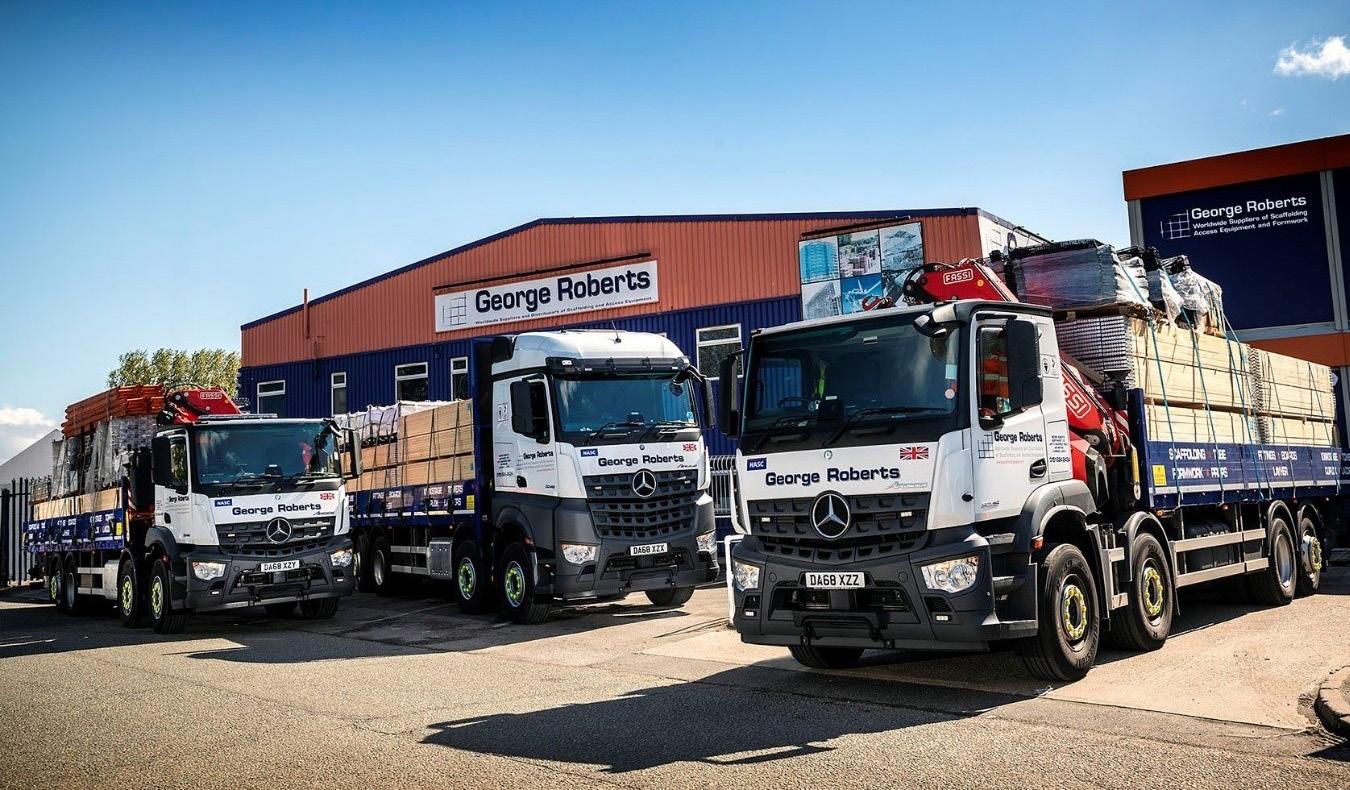
The company’s EOT scheme represents a forward-thinking approach that will benefit employees, customers and the industry as a whole.
and safety, and a FORS-approved transport fleet. The latest accreditation is PEFC, which covers the sustainable and responsible purchase of timber products. Additionally, the company is moving to electric vehicles wherever possible, with all external sales force now using electric vehicles, and efforts under way to convert forklift trucks from diesel to electric to reduce the carbon footprint further.
Reflecting on the company’s journey, Mr. Roberts shared, “From humble beginnings, I am still amazed at what the company has achieved. I just enjoy coming to work every day – it’s not even like going to work; I love every minute of it. It’s hard to pin down one thing, really, but a big thrill is seeing young people who have been on the tools decide to have a go and start their own business. Over 32 years, there have been many, and it’s a source of pride that there are so many now-established scaffolding companies out there who we knew and worked with at the start of their journeys. If someone comes in to see me who has just started up, I love to back them and watch them grow. We all need a chance in life, don’t we?”
Mr. Roberts attributes much of the company’s success to his industry knowledge and sales experience. “First and foremost, I’ve always been a
salesman at heart. Apart from watching Liverpool FC, selling scaffolding is probably my favourite thing to do! I was a Sales Rep for Palmers in the early stages of my career, before mobile phones and email, and it was a tough job, but I loved it. The things I learned in that job I still use every day,” he said.
George Roberts (North West) Limited remains committed to its core values and continues to set the standard for innovation and excellence in the scaffolding industry. As the company charts this new course with the Employee Ownership Trust, it remains focused on quality, customer satisfaction and sustainable growth, ensuring a bright future for all its stakeholders. This strategic move secures the company’s future and reinforces its dedication to maintaining the highest standards of service and quality in the industry.
In conclusion, the establishment of the Employee Ownership Trust at George Roberts (North West) Limited represents a forward-thinking approach that will benefit employees, customers and the industry as a whole. As the company charts this new course, it remains committed to the values that have driven its success for over three decades, ensuring continued growth and shared prosperity for years to come.
FIRST AND FOREMOST, I’VE ALWAYS BEEN A SALESMAN AT HEART. APART FROM WATCHING LIVERPOOL FC, SELLING SCAFFOLDING IS PROBABLY MY FAVOURITE THING TO DO
















IIndustry leader Des Moore explores how to build a stable business – something that scaffolding businesses need to consider at all times, but which becomes even more critical during volatile economic periods
n my previous articles for ScaffMag, I’ve talked about how to scale a business for sale. In short, the more stable and well-managed a business is, the more attractive it is to a buyer. But even if you have no intention of selling, you should still make it a priority to ensure your business is as strong and resilient as possible.
Not only is this important for your long-term personal success, but your employees rely on you for their livelihoods, and your clients rely on you to support them with their projects. As a company owner or leader, it’s your primary responsibility to build a stable business. And it’s even more important when the economy is volatile, when there are pressures on the sector, and when an election is looming – all of which we are facing at the moment.
In this article, I’m going to cover the business fundamentals that contribute to creating a strong business. These principles apply to companies of all sizes and in all stages of growth.
Every business should have a ‘raison d’être’ – you may wonder what this is. It’s simply a statement that sets out your company’s reason for being. You should also have a
vision of where you want the business to be in the next five years, and you should have a set of values that reflects your individual approach. This shows your clients that you have a clear purpose, and that your employees understand what that purpose is. It also gives you a clear target for where you want your business to go –and that forms the central part of your business strategy.
A strong business has to be built on the details. This means having an up-to-date budget that supports your business strategy. It means ongoing cashflow management, and it means having an action plan that sets out how you are going to achieve your goals. You should also consider essential factors like timely agreements of variations to contracts, as this can have a significant detrimental impact on your working capital. Measure your progress against these strategies on a regular basis – at least once per month – so you can make any changes you need.
The broader your spread of work, the less reliant you are on one customer or one job. You’re also not committing all your
resources and equipment in one place, so you are lowering your risk all round. By taking on a range of project sizes, for example, you can make sure you are keeping your cashflow healthy and not overcommitting the business to any one project.
It’s important to build good relationships with your customers, and take on plenty of repeat work. But if you only have a small number of main customers, you are creating a huge potential risk for your business. What happens to your company if one or more of those companies fail, or you fall out with them? You will lose a significant proportion of your work overnight, and this could put you in a very difficult position – particularly if there is a large amount owed to you. If you are in this position now, you should look for ways to balance these customers with other work, to give you a safety blanket sooner rather than later.
Every business has risk. The question is, how much are you prepared to accept? If your aim is to build a stable business that can withstand market, economic or
any other shocks, you need to accept a level of risk, but minimise it where possible. I’d say have at least 75% of your business insured. Be realistic and detailed about the risks facing your business, mitigate them wherever possible and review them regularly.
Every sector is subject to its own risk. So, to protect your business, it’s safest to spread your work across several sectors. For me, four sectors is optimal – you are able to understand your customers’ needs and develop expertise in each sector, but you are not overcommitted to any single one, and you will know the risk to your business of work disappearing from any one of those sectors. In particular, stand back and look at the types of contracts you have – are they progressive, where you are regularly supplying scaffolding so your cashflow is constant? Or are they static, where you get a payment when the scaffold is erected and then nothing for many months – or even years – until it’s time to take it down?
When smaller or owner-managed businesses fail, it’s often because of poor cashflow management. It’s absolutely imperative to understand both how cash comes into your business and how it goes out. Generally, this is referred to as Days Sales Outstanding (DSO) – the number of days it takes for payments to come in from clients – and Days Payable Outstanding (DPO) – the time it takes to pay your own suppliers. Simply put, if you don’t have a grip on this, you could end up with a mismatch that has a serious impact on your cash position, and your working capital will be squeezed.
We have all been in the position where a new customer – no matter how good your due diligence was – doesn’t pay their bill. Usually called a ‘trade credit’ insurance policy, this insurance helps to protect your
business against non-payment. It can help to mitigate a common risk faced by the scaffolding industry. I’ve always had this – and so should you.
Large, exceptional contracts are very tempting. You can see that they will bring in good income, and they may improve your market reputation or result in increased work with a new client. However, these exceptional projects come with their own complications. You will need to commit significant equipment and workforce to them, for example, so your overheads will increase. Large projects also tend to pay on much longer terms, which could affect your cash flow, and you could end up failing to serve your existing customers well because you have been distracted by a more ‘glamorous’ option. And, when these jobs are finished, they invariably leave a large hole that can take two or three years to fill – all while you are still carrying those overheads. I could cite several examples of this – but it would be unprofessional to name the individual companies concerned.
Project reviews help you to plan ahead, manage your workforce and learn lessons from challenges or failures. For example, reviewing work on an ongoing basis allows you to make any necessary changes to processes, work with your clients to resolve problems and show that you take a proactive approach.
I am a strong believer in helping clients to succeed. Your business is not just here to provide a hands-off service; it’s here to help your clients flourish – if they don’t, you won’t. So invest time in advising your clients on the best, and most cost-effective way to do things, not just at tender stage, but during the course of the project. This will help you build strong relationships and increase the likelihood of repeat business and referrals.
Employees should feel that they have some ownership and shared values of the company they work for. The more involved and engaged your team is, the more successful you will be. So be clear about vision and values, ask them to take part in key discussions and always be transparent with them, irrespective of the position they hold – from apprentices in the yard to directors in the boardroom. This doesn’t just mean ‘telling’ them things –it means explaining your decisions so that they can see your thinking. Be open, be clear and be honest, and if your people are still unclear, take the time to go through it again. I guarantee that this will pay significant dividends in the future.
The first thing to do is assess where your business is now. Look at your current clients by project value and sector. Think about the potential risks to your business and how you are mitigating them. Pay attention to your cashflow and working capital to get a clear idea of the financial stability of your business. And make sure you have a clear purpose and business strategy to give you the focus you need. Ask yourself this question: If there was a recession tomorrow, what would I do to protect my business and my workforce? Whatever the answer is, you should already be doing it today. I can help you with this initial assessment, showing you where your strengths, weaknesses and opportunities are, so that you can take the right steps to build a strong and stable business for the future.
Business consultancy, but not as you know it.
Straight-talking, valuable business advice you can trust, backed up by 30 years’ senior leadership experience in the Scaffolding and Access Industry


Des Moore Founder
“I would have absolutely no hesitationrecommending Des,hedeliveredgood value on what we spent.”
“Deshasprovedinvaluable insavingustimeand helpingusnavigatethenext stagesofourgrowthplan.”
COMMERCIAL STRATEGY
GROWTH STRATEGY
CORPORATE STRUCTURE AND OPERATIONS
FINANCE PRODUCTS AND EQUIPMENT
ADDITIONAL SERVICES
From hand drawings to visualisation: The evolution of scaffolding design. The use of advanced modelling technologies has transformed traditional scaffolding design methods, enhancing accuracy, safety and efficiency. From basic A1 drawings to immersive virtual reality, these modern design approaches have revolutionised scaffolding projects. Millcroft’s Senior Design Engineer, Michael Egan, discusses how advanced modelling techniques improve the scaffolding design process
Scaffolding design has come a long way from the original approach of A1 drawings to scale. Although this method served its purpose, it was time-consuming and lacked the ability to thoroughly visualise and analyse the complexities of the structure. In addition, if changes were made, designers had to literally go back to the drawing board and redraw the design.
Thankfully, the industry has moved on from the early days of manually drawing to scale. Today, many companies use a more digitised twodimensional design using 2D CAD software like Autocad. However, for some companies, like Millcroft, the transition to 3D modelling has been a game-changer. Unlike traditional 2D CAD software, 3D modelling provides a complete visual representation of a structure. However, 3D software is still mainly geared towards permanent structures, so finding the right product for temporary structures can be challenging. Software is available but it tends to have poor visual outputs and can be costly.
Nevertheless, 3D modelling can still provide a complete visual representation of the temporary
scaffolding scheme. This comprehensive model allows designers to detect potential clashes with existing structures prior to construction, preventing costly delays and reworking. As technology advances, the aim is to combine a 3D structural model with a 3D visual model to further streamline the design process and include features such as standard loads and tie loads in all locations.
Generating a 3D model requires the inputting of accurate data. Ensuring the correct modelling of all members, including fixities of each member and support types, is vital to ensure the frame analysis is correct, as the output results are only as reliable as the input data. At Millcroft, we are integrating the LayPlan CAD plugin into our Autodesk CAD design workflow to 3D model our Layher structures using their entire product library. This allows us to build a 3D model in CAD using the plugin and then export the 3D stick model to use in our structural analysis software. Additionally, we can send our 3D model to Layher who can visualise it and create a virtual reality (VR) environment for us to share with our client.
Ensuring the structural integrity of scaffolding design is essential. 3D modelling software can analyse scaffolding structures under various load

BY FULLY IMMERSING CLIENTS IN THE DESIGNED STRUCTURES THROUGH VR, COMPANIES CAN PROVIDE A BETTER UNDERSTANDING OF THE SCAFFOLDING AND ITS POTENTIAL RESTRICTIONS OR LIMITATIONS
conditions simultaneously. Previously, the worst case conditions, based on experience, would be checked, but 3D modelling ensures the structure is safe in all loading scenarios. Tools like Dlubal RWind can also simulate wind effects, providing an even more accurate analysis where required for structures with complex geometry.
Traditional methods often overlook second-order displacement effects, such as those analysed through P-Delta analysis. However, with advanced structural analysis software, engineers can incorporate vertical loading with lateral wind forces and member offsets due to couplers to simulate realistic lateral displacement. This approach provides a more thorough understanding of the structure’s response to dynamic forces, enhancing safety and reliability in the design process.
One of the most important advantages of 3D modelling is its contribution to enhanced safety in scaffolding design. By providing a complete visual representation, potential hazards and working at height risks can be identified early in the design process, enabling appropriate control measures to be implemented before construction begins. This proactive approach prioritises worker safety and helps mitigate potential delays and costly accidents.
Additionally, collaborative tools within 3D modelling software encourage better communication and coordination among design engineers, construction teams and other stakeholders. This helps to create a more integrated approach to project delivery.
In addition to safety enhancements, advanced modelling techniques can offer significant sustainability benefits in scaffolding design. Optimising structures through 3D modelling can reduce material requirements, construction time and, ultimately, the carbon footprint of each project. This enables companies to contribute to a more sustainable construction industry while still delivering high-quality solutions.
While 3D modelling can be transformative for the scaffolding industry, some challenges still exist in fully utilising this technology. Overcoming resistance to change and ensuring competency still need to be worked on. Some engineers may prefer to stick to the traditional methods they are familiar with instead of embracing new technologies. Additionally, it is important to ensure that designers are sufficiently trained and skilled in using advanced modelling software to avoid errors and inaccuracies that could potentially

jeopardise structural integrity, safety and efficiency.
Advances in automation and artificial intelligence (AI) will also play a crucial role in shaping the future of scaffolding design. Automating repetitive tasks and using AI for design optimisation could streamline processes, reduce manual effort and lead to more efficient and sustainable solutions.
Millcroft is investing in training and development initiatives to address these challenges, including modelling workshops and collaborating with external CAT 3 checkers. By providing our engineers with the necessary skills and knowledge in advanced modelling techniques, we ensure our teams are equipped to tackle the complexities of modern scaffolding design and are up to speed with industry trends and developments.
While the adoption of 3D modelling is still not widespread in our industry, technology and capabilities continue to advance rapidly. 4D modelling and immersive visualisation through VR are launching scaffolding design to new heights.
At Millcroft, we are already seeing the benefits of 3D modelling in delivering innovative and efficient solutions and are using 3D across our scaffold and construction teams. We are incorporating 3D

modelling into design projects to give our clients a thorough understanding of the construction sequence and timeline. This is particularly useful for the tender process as we can offer a detailed project schedule, including completion date, stock requirements and material delivery plans.
The integration of VR also presents exciting opportunities for greater client understanding and collaboration. By fully immersing clients in the designed structures through VR, companies can provide a better understanding of the scaffolding and its potential restrictions or limitations. This experience will enable more informed decisionmaking and design refinements at an early stage.
As our industry continues to evolve, using advanced modelling technologies for scaffolding design is becoming increasingly important. The shift from 2D models to immersive modelling is transforming designs. Adopting these technologies, and investing in training and development, leads to safer and more sustainable scaffolding solutions.
Importantly, using cutting-edge modelling techniques and visualisation tools can also make a career in scaffolding more appealing and help attract much-needed new talent to the sector.
Millcroft is investing in training and development initiatives for its virtual reality (VR) modelling.
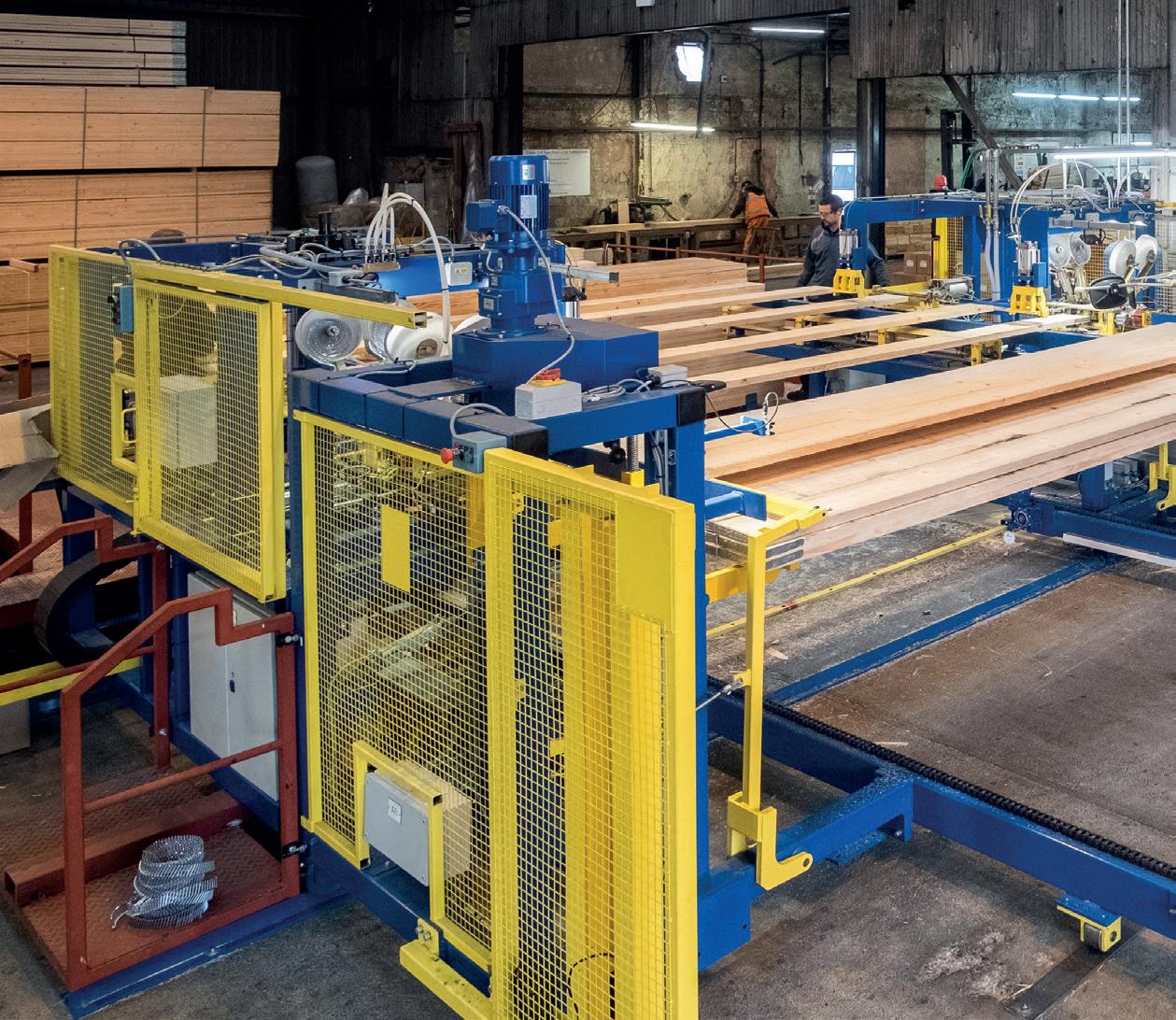






Traditional tube-andfitting scaffolding is the backbone of many UK construction projects, but it also comes with inherent risks, one of which is fire. To mitigate this, fire-retardant scaffold boards are crucial. Brent Scaffold Boards exemplifies this dedication to safety

Brent Scaffold Boards is a family business, based in Yorkshire, that has been supplying quality scaffold boards to the UK construction industry for over 30 years. They prioritise safety and offer fire-retardant-treated scaffold boards to customers working in high-risk environments. To achieve this, they have partnered with FireWright, a company that specialises in sustainable wood treatments.
FireWright’s unique process doesn’t just coat the wood; it impregnates the cell structure of the scaffold boards with a non-toxic, biodegradable fire retardant. This ensures the entire board is protected. Additionally, the treatment meets the stringent Euroclass B,s1,d0 fire safety specification, preventing oxygen from fuelling potential fires.
Brent Scaffold Boards employs highly trained graders, consistently assessed for
quality assurance. The company’s recent investments in a second stress grading line and additional banding machines allow them to produce an impressive volume of fire-retardant boards each week, upholding both efficiency and safety standards.
POWER OF PARTNERSHIP
Collaborations between suppliers like Brent Scaffold Boards and treatment specialists like FireWright are key to enhancing construction site safety. As more of their treated boards are

used, construction sites become safer. With stricter safety regulations in the construction industry, the use of materials like fire-retardant scaffold boards is becoming more essential than ever. This is due to a growing awareness of the dangers posed by fires on construction sites.
These fires can have devastating consequences, causing injuries, fatalities and millions of pounds in property damage. Fire-retardant scaffold boards play a crucial role in mitigating these risks by delaying the spread of flames, buying valuable time for evacuation and firefighting efforts.
Companies like Brent Scaffold Boards are at the forefront of promoting safety in the construction industry. By working with specialists like FireWright to develop and supply high-quality fire-retardant materials, they are helping to create safer working environments for everyone on the construction site.
Scaffolders face some of the most demanding and hazardous conditions in the construction industry. The ARESTA Ultra Lightweight Height Safety Helmet is designed specifically to meet their unique needs, offering exceptional comfort, protection and practicality


Adhering to the rigorous EN12492 and EN397 safety standards, this helmet ensures maximum safety and efficiency for professionals working at heights.
Weighing in at a mere 397g, the ARESTA Ultra is the lightest height safety helmet on the market. This ultralightweight design significantly reduces fatigue for scaffolders, who often wear their helmets for long hours, enhancing overall productivity and comfort.
Ventilation is crucial for scaffolders working in varied and often extreme weather conditions. The ARESTA Ultra is equipped with 10 strategically placed vents that ensure optimal airflow, keeping users cool and comfortable. This enhanced ventilation system helps maintain focus and efficiency, even during strenuous tasks.
The helmet’s fit is both adjustable and secure. It features a four-point chin strap with a quick-turn adjuster. This design ensures a snug and comfortable fit, which is crucial for minimising the risk of the helmet being dislodged during a fall.
The adjustable headlock buckle, made from PA webbing, adds stability, while the washable pads offer lasting comfort, making the helmet suitable for long-duration use.
Constructed from high-quality ABS+PP, the helmet’s shell offers superior shock resistance. The internal moulded technology ensures even force distribution upon impact, maximising head protection. This advanced impact protection is essential for scaffolders often exposed to the risk of falling objects and sudden impacts.
The ARESTA Ultra also provides multiple customisation options, making it highly versatile for various scaffolding applications. Side slots for mounting hearing protection and four clips for
attaching a headlamp enhance its functionality. Additionally, companies can personalise the helmet with their logo or details, promoting both safety and brand identity.
Meeting EN12492 and EN397 standards against shock and penetration, the ARESTA Ultra guarantees comprehensive protection against shock and penetration. Its certification by MNA Lab (NB2841) further validates its reliability and safety, giving scaffolders the confidence to focus on their work.
Available in various colours, including red, yellow, blue, black, orange, white and green, the ARESTA Ultra allows users to choose according to their preference or company branding. It is designed to fit head circumferences ranging from 51–62cm, ensuring a secure fit for a wide range of scaffolders.
The helmet features an external shell made from ABS and an internal shell from PA, with EPP foam providing additional protection. Despite its robust construction, the helmet weighs only 397g. Six side vents and four back vents ensure excellent airflow. A neodymium magnetic buckle allows for easy onehand operation, and top-quality, sweatabsorbing pads can be removed and washed. The PA6 raw material ratchet system ensures a perfect fit adjustment. Safety and comfort are paramount for scaffolders. The ARESTA Ultra Lightweight Height Safety Helmet offers the perfect combination of advanced materials, superior safety features and ergonomic design. By providing exceptional protection and comfort, it enables scaffolders to perform their jobs efficiently and safely.
For more details, visit www.xenithheights.com or contact via email at Ian@xenithheights.com





Lightweight Height Safety Helmet with Superior Comfort and Protection (397g)
Ultra-Lightweight Design: This helmet boasts the title of lightest height safety helmet available, weighing only 397 grams for maximized comfort during extended wear.
Enhanced Ventilation: Equipped with 10 strategically placed vents, this helmet offers excellent airflow to keep you cool and comfortable on the job.
Adjustable & Secure Fit: The 4-point chin strap with a quick-turn adjuster ensures a secure and comfortable fit, minimizing the risk of losing the helmet during a fall. The adjustable headlock buckle with PA webbing further enhances stability, while the washable pads provide lasting comfort.
Advanced Impact Protection: The helmet's high-quality ABS+PP shell delivers superior shock resistance. Internal Moulded Technology ensures even distribution of force upon impact, maximizing head protection.
Multiple Customization Options: The helmet features side slots for mounting hearing protection and four clips for attaching a headlamp with an elastic headband. Additionally, personalization is available to add your logo or company details.
Conforms to Safety Standards: This helmet meets the EN12492 and EN397 Industrial Standards for both shock and penetration protection.
Multiple Colors: Available in a wide range of colors including Red, Yellow, Blue, Black, Orange, White, and Green to suit your preference.
Adjustable Head Circumference: Fits head circumferences ranging from 51-62cm.
High comfort webbing providing comfort for long duration of use and prventing build up of sweat.



In the bustling world of construction, where efficiency and safety are paramount, KEWAZO stands out as a beacon of innovation. With offices in Munich, Germany, and Houston, USA, this leading construction robotics company is transforming the industry with its cutting-edge solution, LIFTBOT. This battery-powered, remotecontrolled lifting robot is designed to automate vertical material handling, significantly enhancing safety and efficiency on both industrial and commercial projects
KEWAZO’s journey began in March 2016 during an interdisciplinary course at UnternehmerTUM, called Think. Make.Start. This innovative programme brought together students from various fields, encouraging them to collaborate and think creatively about solving real-world problems.
Their initial focus was on the inefficiencies and safety challenges inherent in traditional construction methods, particularly in scaffolding assembly. Recognising the potential for robotics to revolutionise this industry, they began working on basic prototypes, experimenting with different concepts and technologies.
The team’s innovative spirit and dedication soon caught the attention of various stakeholders, leading to the securing of public funding, including the prestigious EXIST grant. This support was crucial in the early stages, providing the financial resources needed to refine their prototypes and develop a more concrete concept for using robotics in scaffolding assembly.
From 2016 to 2018, the team focused on overcoming their ambitious project’s technical and logistical challenges. They spent countless hours in labs and on construction sites, testing their prototypes and gathering feedback from industry professionals.
By 2018, their efforts culminated in the official establishment of KEWAZO. This marked a significant turning point, transforming a student project into a formal business entity. The newly formed company quickly attracted the attention of investors, leading to the successful closing of a seed financing round. This influx of capital enabled KEWAZO to expand its team, invest in advanced research and development, and set the stage for its revolutionary impact on the construction industry.
The founders, now equipped with a solid business foundation and a promising technological innovation, were ready to take on the industry. Their early work laid the groundwork for what would become LIFTBOT, a solution poised to redefine material handling and elevate safety and efficiency standards across construction sites and industrial
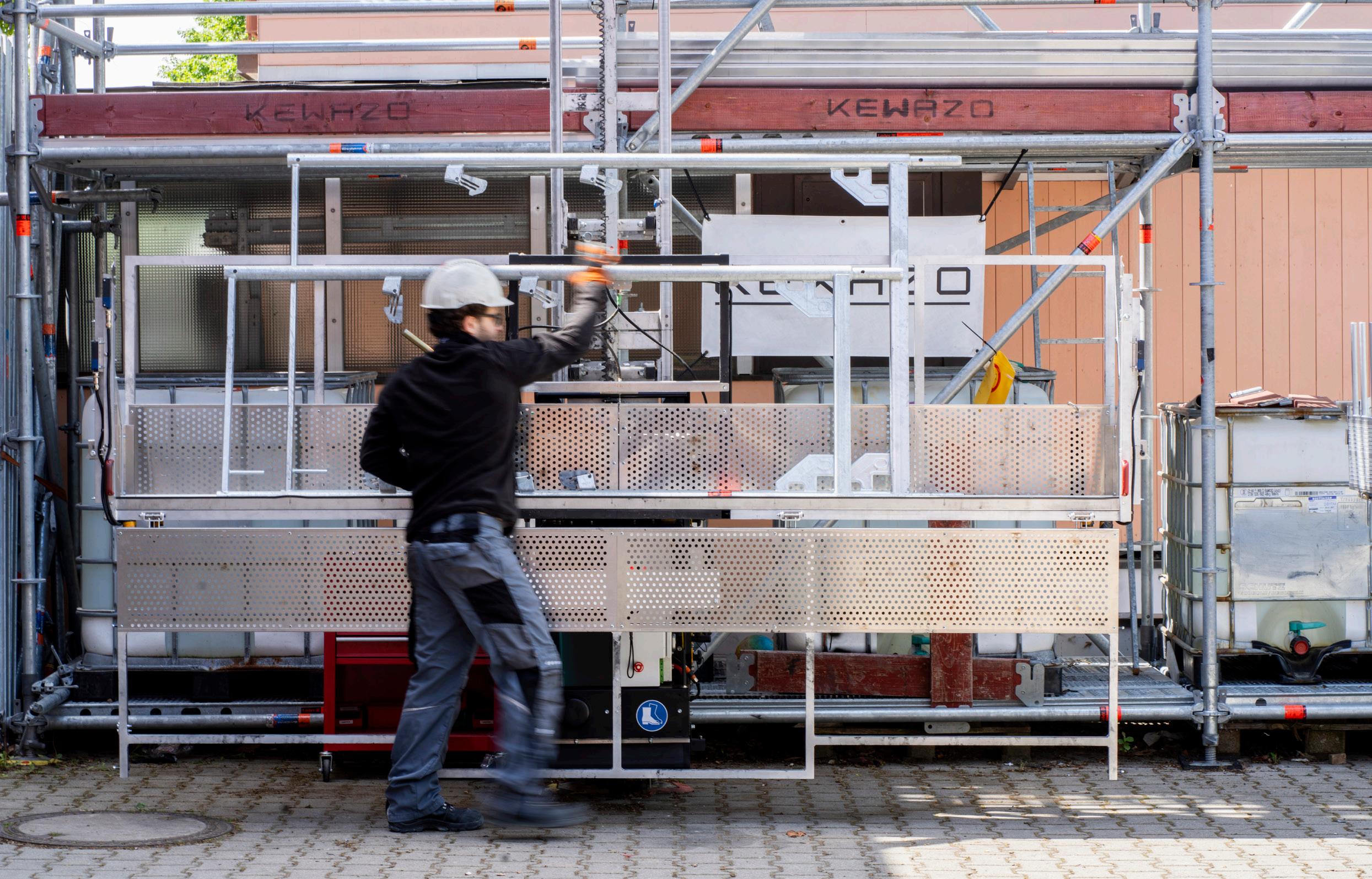
plants globally. KEWAZO’s commitment to innovation and improvement has driven its continuous growth from these humble beginnings to becoming one of the market leaders in construction robotics.
The year 2020 marked a significant milestone for KEWAZO with the launch of the first version of LIFTBOT.
This innovative material hoist became the first of its kind to receive CE certification, a rigorous standard that signifies compliance with European health, safety and environmental protection legislation.
With CE certification in hand, KEWAZO was able to introduce LIFTBOT to a wider audience, delivering the initial series to early customers across Germany. These initial deployments provided invaluable real-world feedback, allowing KEWAZO to refine and optimise LIFTBOT’s functionality and performance. The positive reception from these early users underscored the product’s potential to
KEWAZO
transform material handling in construction, further validating the team’s hard work and vision.
The successful introduction of LIFTBOT was bolstered by the closing of a Series A funding round in the same year. The funding enabled KEWAZO to expand its team, invest in further research and development, and enhance its production capabilities.
This period of growth and development was marked by increased engagement with potential clients and partners.
KEWAZO’s team actively participated in industry events and exhibitions, showcasing LIFTBOT’s capabilities and benefits. Demonstrations highlighted LIFTBOT’s rapid installation, portability and autonomous operation, capturing the interest of construction professionals looking for innovative solutions to improve efficiency and safety on their sites.
As KEWAZO continued to gain traction in the market, it established partnerships with key players in the construction industry. These collaborations facilitated the integration of LIFTBOT into various projects, ranging from commercial buildings to industrial facilities.
By the end of 2020, KEWAZO had firmly established itself as a pioneering force in construction robotics, with LIFTBOT setting a new standard for material handling.
KEWAZO’s partnership with Bilfinger in early 2022 facilitated its expansion into the European markets, including Benelux and the UK. This collaboration marked a significant step in KEWAZO’s journey, allowing the company to demonstrate the versatility and effectiveness of LIFTBOT in diverse environments and projects. Bilfinger, a renowned name in the industrial services sector, provided the perfect platform for KEWAZO to showcase its technology to a broader audience.


Shortly after, KEWAZO began working with Altrad, another industry leader, further cementing its presence in the European market. This collaboration extended KEWAZO’s reach, introducing LIFTBOT to new clients and applications in various sectors.
By late 2022, KEWAZO had ventured into high-height commercial projects, predominantly involving system scaffolding. Partnering with industry leaders such as Skill Scaffoldings, KEWAZO undertook notable projects like the children’s hospital in Dublin with McCrory. These highprofile projects not only highlighted the practical benefits of LIFTBOT but also demonstrated its potential to improve safety and efficiency on complex construction sites.
In 2023, KEWAZO’s achievements were recognised with the prestigious Innovation Award from the National Access & Scaffolding Confederation (NASC) in the UK. This accolade underscored the company’s commitment to excellence and innovation in construction robotics. It also provided further validation of LIFTBOT’s impact on the industry, encouraging KEWAZO to continue pushing the boundaries of what is possible with construction automation.
June 2023 marked another significant milestone with the establishment of KEWAZO Inc., the company’s expansion into the US market. This move was strategic, tapping into the vast potential of the American construction industry. KEWAZO quickly secured key clients such as Scaffold Resource, BETCO and Marr Scaffolding, who recognised the transformative potential of LIFTBOT. Scaffold Resource became the first company to deploy LIFTBOT on the iconic US Capitol building, a testament to the robot’s reliability and effectiveness.
LIFTBOT is not just a lifting robot; it represents a paradigm shift in material handling on construction sites. Its rapid installation – requiring just 20 minutes without interrupting ongoing operations – sets it apart from traditional solutions. Being portable, LIFTBOT can be deployed on projects typically reliant on manual labour, circumventing the need for forklifts or cranes for onsite deliveries and unloading. Completely wireless and battery-powered, LIFTBOT

operates autonomously for over 12 hours on a single charge, eliminating the need for manual control and freeing up valuable resources for other tasks. Advanced digital services, including real-time data analytics via KEWAZO ONSITE, provide invaluable insights into project operations, enabling data-driven decisions regarding scheduling, material logistics and performance measurement.
Remote maintenance capabilities ensure minimal downtime, with KEWAZO’s service engineers able to access each LIFTBOT remotely to address technical challenges and perform predictive maintenance. The robot’s enhanced safety features, including 12+ sensors, ensure that it only operates under safe conditions, protecting both the equipment and the workers.
KEWAZO is not resting on its laurels. Recognising the broader need for efficient material transportation beyond scaffolding, the company is developing a new platform for general construction materials. Currently, in the certification process, this platform is set to launch in Q3 2024, promising to streamline construction processes further and elevate the industry standard.
The new platform addresses the common issue of transporting various construction materials at height, which is a frequent requirement across many construction and industrial sites. By expanding its offering, KEWAZO intends to provide a comprehensive solution that enhances the efficiency and safety of material handling in a broader range of applications.
KEWAZO’s innovative journey from a student project to a market leader in construction robotics exemplifies the transformative power of technology and collaboration. With LIFTBOT, KEWAZO is not just automating material handling; it is redefining the future of construction, ensuring safer, more efficient and data-driven project management.
As KEWAZO continues to expand its horizons, the construction industry can look forward to a new era of innovation and excellence.



As a result of a pioneering collaboration, PERI and K2 Scaffolding have delivered a state-of-the-art facade access solution for The National Bank in Belfast, a building renowned for its historical significance and architectural grandeur

The Grade-I listed structure, which is currently undergoing a critical roof upgrade, posed unique challenges due to its delicate framework and the necessity to preserve its aesthetic and structural integrity.
K2 Scaffolding, faced with the task of accessing the building’s facade without compromising its bay windows, turned to PERI’s design expertise for a solution.
Traditional scaffolding methods, which typically involve tying the structure directly to the building, were not feasible due to the potential risk of damage to the building’s delicate areas. PERI’s team rose to the challenge, employing innovative strategies to minimise and strategically position ties, thus ensuring the building’s preservation.
The use of PERI UP console brackets was a game-changer in this project. These brackets, attached to the internal standards of the scaffold, allowed the structure to be stepped back from the facade.
This ingenious approach not only reduced direct contact with the building but also maintained the necessary proximity to carry out the refurbishment work. The brackets extended the
platform’s surface area, effectively bridging the gap between the scaffold and the building, thereby offering a seamless and safe working environment.
One of the project’s most significant challenges was the absence of structural drawings for The National Bank. This meant that PERI’s design team, in collaboration with K2 Scaffolding’s experienced personnel, had to develop a bespoke ‘as-built’ solution.
Through meticulous site surveys and the adaptable nature of PERI UP components, the team succeeded in creating a tailored scaffolding solution that conformed perfectly to the unique shape of the building’s roof.
Moreover, the project included the design of a pavement gantry at ground level to ensure public safety. This feature incorporated a bespoke PERI UP fan, designed to protect pedestrians from any falling objects, showcasing the team’s commitment to safety and innovation.
The collaboration between PERI and K2 Scaffolding not only reinforces the importance of preserving our architectural heritage but also highlights the potential of modern engineering solutions to overcome seemingly insurmountable challenges.
Layher UK, the esteemed provider of system scaffolding solutions, launched its first open morning of 2024 at Simian Risk’s training centre in Leytonstone on Tuesday, 21 May
The event provided a hands-on experience for attendees to observe Layher’s innovative product demonstrations, engage with the team and partake in informal discussions about enhancing business operations with Layher’s solutions.
A key highlight of the morning were the joint presentations by Sean Pike, Layher UK MD and Des Moore, Layher’s
Brand Ambassador. Both are well known in the industry – Des for his remarkable success in driving substantial revenue streams for TRAD Scaffolding through Layher’s Allround® Scaffolding. Both gentlemen shared their extensive knowledge and experience.
Des gave unique insight from the system scaffold users’ perspective. His presentation aimed to shift the industry’s perspective from questioning

the need for system scaffolding to recognising the optimal timing for investing in Layher’s advanced systems. Reflecting on a recent LinkedIn poll about system scaffolding, Des noted, “Although 64% of respondents highlighted the time and cost-saving advantages of system scaffolding, 19% still perceive it as too expensive. With my experience, I beg to differ.” Des emphasised the long-term benefits
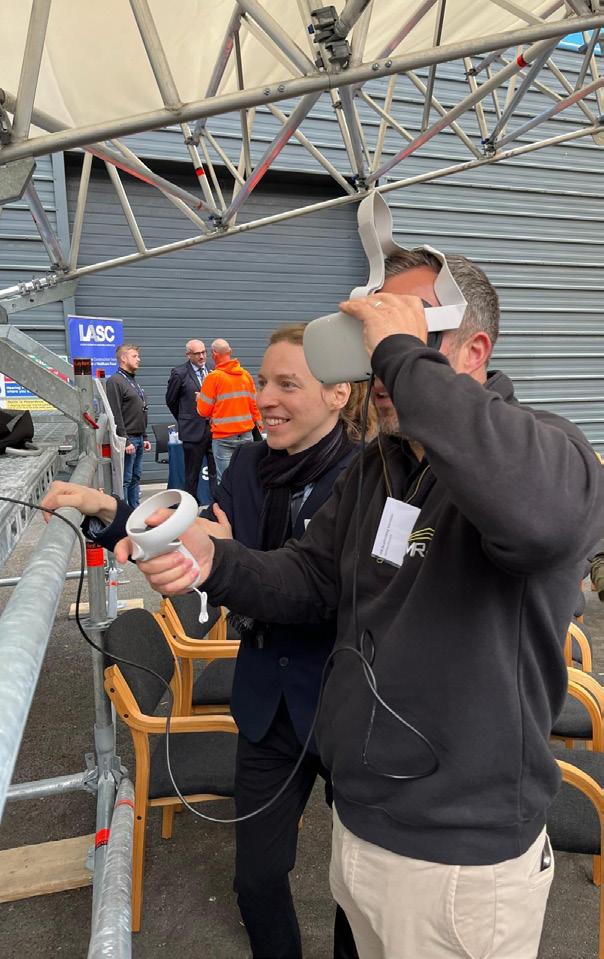
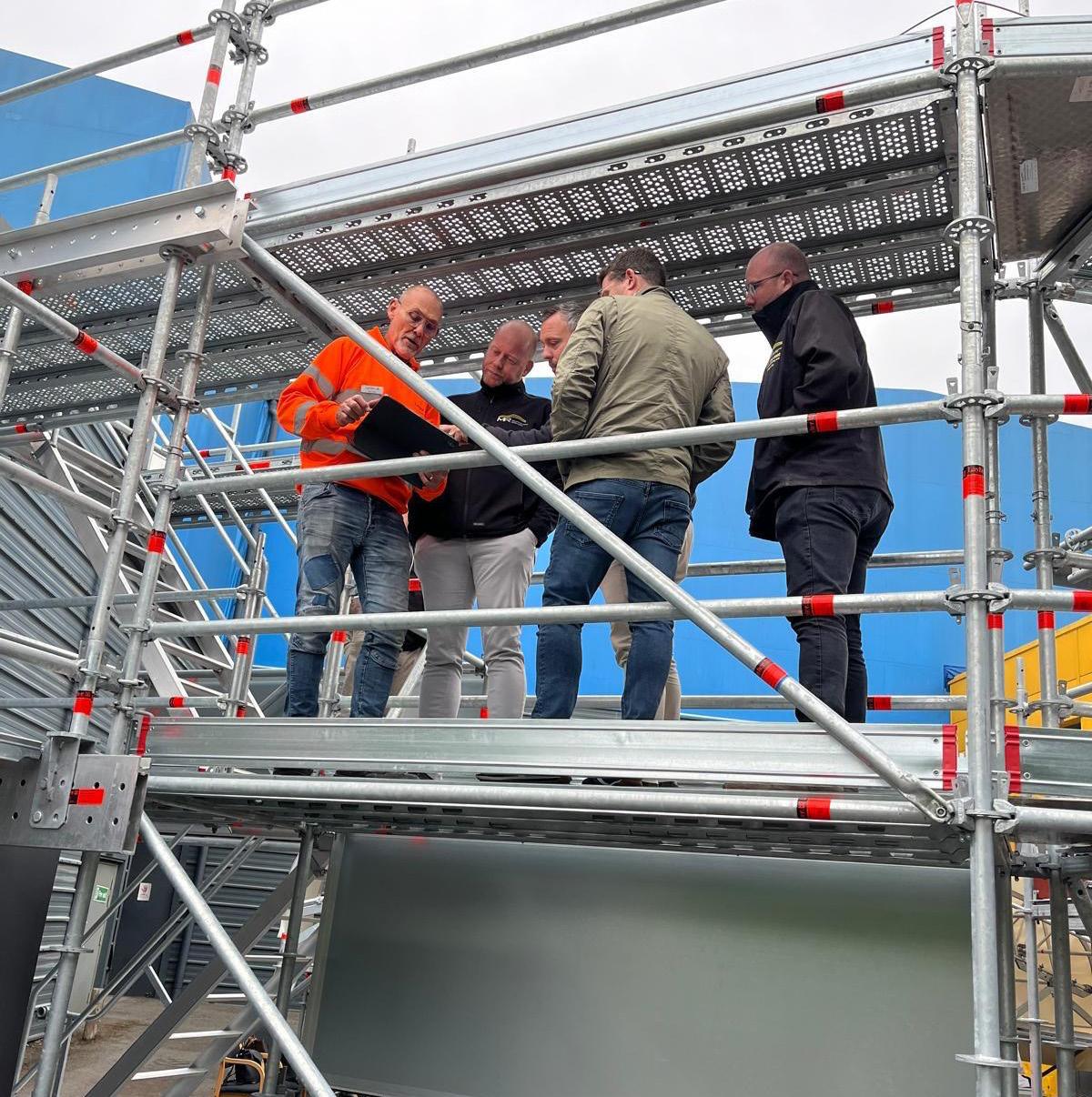

and cost efficiency of system scaffolding, noting its superior longevity and durability compared to traditional scaffolding methods.
The event, which ran from 9 am to 12 pm, had intimate regional attendance, which ensured meaningful interactions and product exploration. Attendees were treated to speeches by Sean Pike, Managing Director at Layher UK, and Des Moore. Sean elaborated on Layher’s core values of strategic partnership via their unique four ‘S’ promise of Service, Support, Solutions and Supply and the significant benefits of their original Allround® Modular Scaffolding System for projects of any size.
The event showcased new products, including Twix and Flex beam, as well as the more established universal products, loading bays and site stairs. It also highlighted solutions, such as splays in
Allround®. The Layher Keder XL Roof was also on display.
Sean Pike highlighted the importance of these events, stating, “We’re committed to providing attendees with a comprehensive understanding of our products and fostering quality conversations. That’s why we’re hosting multiple events throughout the year.”
Des Moore also addressed the financial benefits of Layher’s system scaffolding from a contractor’s standpoint. He illustrated how the initial investment is outweighed by the long-term savings in labour and the potential to enter new markets, leading to significant turnover and margin benefits.
Additionally, Layher showcased its cutting-edge technologies, including LayherSIM (scaffold information
modelling) and LayPLAN VR, which garnered considerable interest. The event also demonstrated the use of Flex Beam for quick and strong street gantry scaffolds and its latest innovation, the Twix Beam, for suspended scaffolds. Layher’s Open Morning Series to Continue Across the UK
The Leytonstone event marks the beginning of Layher’s series of open mornings planned across the UK, with the next events scheduled at Eggborough Depot on 3 September, Livingston Depot on 24 September and West Brom on 8 October.
These events provide a unique opportunity for industry professionals to explore Layher’s innovative scaffolding solutions and their practical and financial benefits, paving the way for enhanced efficiency and profitability within the construction sector.

The Flydeck system’s lightweight, easily stowable components, combined with faster and safer elastic pin joints, resulted in significant time and cost savings while improving overall safety
Agroundbreaking scaffolding project on a major national highway recently concluded, showcasing innovative engineering solutions to tackle a complex refurbishment challenge. However, the project was not without its hurdles. The bridge’s location made traditional scaffolding methods impractical, and its exposure to harsh weather and heavy traffic posed significant challenges.
The arch bridge, a majestic structure carrying traffic across a hydroelectric basin, required significant refurbishment after decades of service. The bridge’s impressive span of 406 metres and its exposure to harsh weather and heavy traffic had taken their toll, necessitating a comprehensive restoration project.
Pilosio, a leading scaffolding manufacturer, stepped in with their revolutionary Flydeck system. This system, unlike traditional scaffolding, offers a suspended working platform solution by anchoring decks to the viaduct’s concrete structure using chains, allowing workers safe access to all areas of the bridge.

The Pilosio solution set-up was crucial to service the viaduct’s piles, beams, spandrels and carriageway slabs:
• Approximately 11,000m2 of Flydeck with 25cm beams, longitudinal set-up: under the entire width of the underdeck intrados (beams, spandrels and carriageway slabs). The system was installed in four phases, approximately 3,000m2 for each phase.
• Approximately 3,000m2 of Flydeck with 25cm beams, transversal stepped set-up. The system was installed in two phases, approximately 1,500m2 for each phase.
• An approximately 150m Flydeck catwalk was created in a longitudinal set-up connecting one span to the next. The catwalk made material handling quick.
• Electric single-column scaffolds and connecting walkways were deployed to ensure comprehensive access and efficient intervention.
Worker safety was paramount in this scaffolding project.
THE VIADUCT REFURBISHMENT PROJECT IS NOT JUST A SUCCESSFUL CASE STUDY BUT A TESTAMENT TO THE INGENUITY OF MODERN ENGINEERING SOLUTIONS
The decks were always anchored and never cantilevered, significantly reducing the risks associated with working at height. Moreover, the Flyrail guide, another innovative design by Pilosio, supported the weight of cantilevered beams during installation, ensuring stability and minimising the risk of accidents. Thanks to the Flydeck, the roadway was not closed during the entire maintenance of the project.
However, the viaduct refurbishment project is not just a successful case study but a testament to the ingenuity of modern engineering solutions. By embracing innovative approaches like the Flydeck system, construction companies can overcome complex challenges and deliver successful projects.
This not only prioritises worker safety and efficiency but also sets a new standard for the industry, encouraging the adoption of similar innovative solutions.




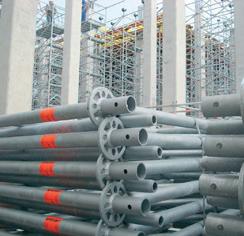






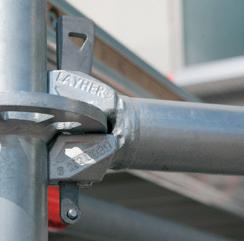
















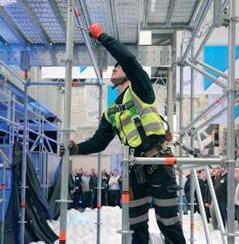






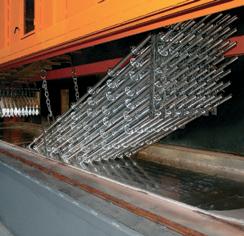



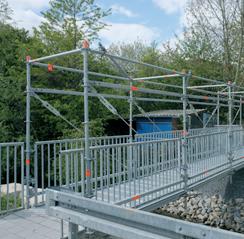




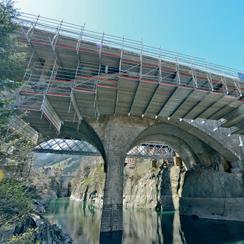

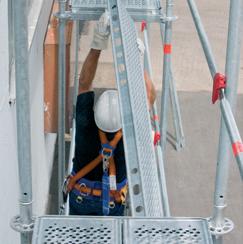
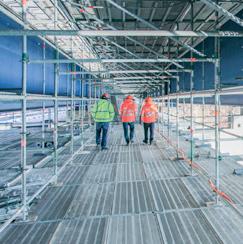















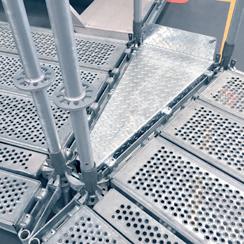












































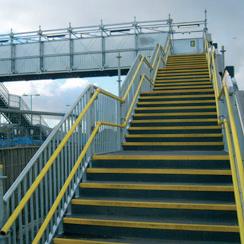
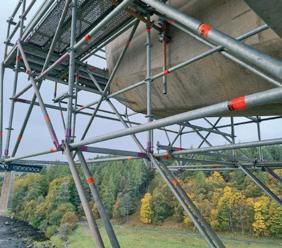







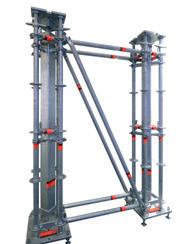

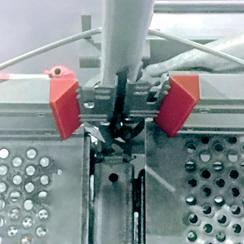



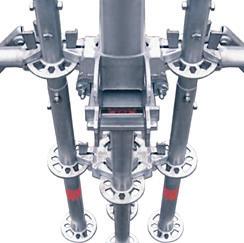



For more than 75 years, Layher has focused on innovation not imitation.
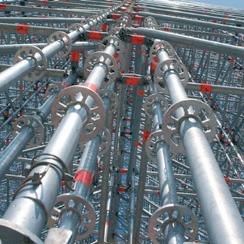


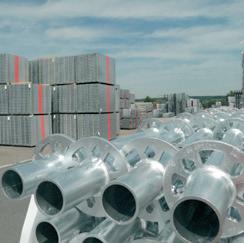

It’s why we remain the past, present and future of system scaffolding.









WINNER NASCInnovation oftheYearAward2021 LayherAllroundAGSFaçadeSystem



● Henderson’s Relish Factory, Sheffield
● Oxford University, Oxford


Sheffield, a city celebrated for its rich industrial heritage, is witnessing the transformation of one of its most iconic landmarks – the former Henderson’s Relish factory
This ambitious three-year restoration project, led by Assix Construct, began in December 2021. Its goal is to preserve the historical integrity of the beloved factory while repurposing it for modern use.
The primary objective of this restoration is to breathe new life into the historic factory, a symbol of Sheffield’s cultural legacy. The project entails extensive scaffolding work, crucial for supporting the building during the renovation. This scaffolding ensures that the historical facade remains intact while the interior undergoes significant modifications.
The scale of the project is substantial, involving significant height and multiple levels of scaffolding. Access scaffolds and raking shores have been set up on three sides of the building to support three walls. This scaffolding was essential for the facade retention work, which included vertical propping and the use of strongboys to prevent lateral movement. To ensure safe working conditions, a 2.5-metre clearance around all sides has been maintained.
Preserving the historical facade while upgrading the internal structure posed significant architectural and environmental challenges. The team at
Assix Construct had to strike a delicate balance between maintaining the building’s historical integrity and implementing modern construction techniques. Environmentally, the project aimed to minimise disruption to the surrounding area and preserve as much of the original construction materials as possible.
Prior to the design and installation of the external access scaffold and facade retention, there was concern over the existing basement retaining walls’ ability to withstand the excessive surcharge loads from these external scaffolds. The design team, alongside Rowland Scaffolding and Assix Construct, developed a complex flying shore system using scaffold ladder beams and concrete anchors to safely support the surcharge loads temporarily while avoiding clashes with the newly proposed concrete piles, caps and ground beams.
The scheme also required phasing to accommodate a congested programme of works, necessitating the shoring to be in place prior to the external scaffolds. However, the basement needed to be backfilled while these works were ongoing. This involved designing a specific programme for pouring concrete in layers in the basement, allowing the shoring scaffold to be progressively stripped without having to bury the scaffold items sacrificially.
Facade retention scaffolds were designed and erected on three sides of the existing building. There were significant site constraints as the site hoarding allowed only for a narrow scaffold and buttress along two sides, with the third side facing directly onto a major road through Sheffield, limiting the width to that of the independent scaffold itself. Due to the nature of the required scaffold and the constraints, a large amount of kentledge was needed in the design, contributing significantly to the concern over the basement retaining walls.
Cameron Hardy, who was part of the temporary works from Creator Scaffold Design, commented, “This project has

been both a challenging and rewarding experience for the entire team. Our efforts have focused on preserving the building’s historical essence while ensuring it meets modern standards. It was a proud accomplishment to be involved with this project due to the status of the building and its significance as a local cultural legacy. The support from the local community and heritage organisations has been invaluable in driving this project to success.”
The project’s execution was methodically planned and divided into key stages. Initially, access scaffolds and raking shores were erected to support three sides of the building. This was followed by the facade retention stage, involving the installation of vertical propping and strongboys to stabilise the facade. Subsequently, the roof and internal floors were carefully demolished and reconstructed, with continuous support from the scaffolding system, to maintain stability.
Throughout the project, significant adaptations were made to scaffold configurations to address structural challenges and enhance safety measures. The project involved close collaboration with Burflex Scaffolding for the access scaffolds and raking shores. Structural engineers ensured the stability of the facade retention system, and regular consultations with safety inspectors maintained high safety standards.
A representative from Assix Construct added, “The meticulous planning and execution of this restoration project highlight the importance of innovative solutions and adaptability. We are proud to contribute to the preservation of Sheffield’s architectural heritage.”
The restoration of the Former Henderson’s Relish Factory is on track for successful completion, overcoming significant challenges related to preserving the historical facade while upgrading the internal structure. Lessons learned from the project highlight the importance of detailed planning, flexibility in adapting to structural challenges, and the value of innovative scaffolding solutions. Continuous communication and collaboration with all stakeholders have been pivotal in driving the project’s success.
The project has garnered praise from local heritage organisations for its commitment to preserving Sheffield’s architectural heritage. Once completed, it is expected to serve as a shining example of successful historical restoration, enhancing the city’s cultural landscape.
As the project nears its final stages, Sheffield eagerly anticipates the revitalisation of this cherished landmark, symbolising the city’s ability to honour its past while embracing the future.
Oxford University, a bastion of academic excellence, is renowned for its architectural beauty. Now, led by Laing O’Rourke, a new state-of-the-art humanities building is taking shape, featuring a spectacular 500-seat concert hall, lecture rooms and study spaces.
At the core of this ambitious project lies an extraordinary scaffolding access solution for the construction of the auditorium’s intricate ceiling, which is a testament to Layher UK’s ingenuity and the skilful execution by scaffolding experts H&H Contract Scaffolding Ltd.
The initial plan involved erecting a traditional 36m x 15m birdcage scaffold with eight 2m lifts, projected to take approximately two months for construction. This timescale conflicted with the project timeline, prompting the search for a more efficient solution.
The objective shifted towards a ‘hanging scaffold’ design, suspended directly from the concrete roof slab via preformed lighting holes. This unprecedented approach aimed to free up valuable ground-level space, enabling construction work to continue unhindered.
A conventional tube-and-fitting
approach was deemed too complex to accommodate the required 2kNm2 loading. The solution arrived with Layher UK’s modular Allround system, which is world-renowned for its versatility and strength.
Layher’s innovative new Twix and Flex Beams, integrated with their standard steel decks, provided the backbone for the suspended working platform. To ensure safe and efficient assembly, the entire scaffold was designed to be erected from spider MEWPs, and materials were craned into the concert hall before the roof slab was completed.
“The innovative scaffolding solution we’ve implemented at Oxford Humanities has been a game-changer, providing a triple win for our project,” said Jack Higgins, Construction Manager at Laing O’Rourke.
“Compared to a traditional birdcage scaffold, this suspended platform allowed us to maximise productivity by working simultaneously above and below the structure. The rapid installation time significantly minimised disruption to our construction schedule, and the reduced material requirement simplified logistics and mitigated the risk of damage to
finishes. Put simply, delivering this project on our tight timeline wouldn’t have been possible without this impressive scaffolding solution.”
Underscoring the collaborative spirit of this project, during the planning phase, H&H Contract Scaffolding Ltd. was invited to Layher UK headquarters in Letchworth for a pre-build test of the scaffold design, with Layher’s after sales specialist support provider.
This proactive approach ensured a seamless and efficient real-world installation, which Layher further supported during the actual build too.
However, this wasn’t just a courtesy visit, it was a chance for H&H Scaffolding’s team to work through the plans and assemble the structure on the ground under controlled conditions, ironing out any unforeseen complications before the actual installation began at the Oxford University site. This minimised risks, ensured a flawless assembly process and saved valuable time on the project.
At the heart of this impressive structure are Layher’s renowned Allround system scaffolding and the integration of their
versatile Flex and Twix Beams. This combination represents the pinnacle of Layher’s engineering expertise.
The Allround system is a modular scaffolding solution renowned for its versatility, strength and ease of use. Its components can be swiftly configured into a wide range of structures, making it ideal for complex projects like this one.
Layher’s Flex and Twix Beams add another adaptability dimension to the equation. These innovative new beams offer exceptional load-bearing capacities. They can be seamlessly integrated with the Allround system, creating expansive working platforms that can handle significant weight, whilst providing additional flexibility and solutions to difficult aspects of any site requirements.
EXPERTISE: H&H CONTRACT SCAFFOLDING
The Oxford-based firm H&H Contract Scaffolding Ltd has a proven track record, having collaborated with the main contractor on numerous projects. This auditorium marks their 18th project at Oxford University, showcasing their in-depth understanding of the university’s unique requirements.
“My guys have done an incredible job on this project,” remarked Andy Thomas, Managing Director of H&H Contract Scaffolding Ltd. “The Layher system and both the Flex Beam and Twix Beam are fantastic bits of kit, and Layher UK have supported us every step of the way. From the incredible engineering of the scaffold design to the support we received in understanding what can be achieved with the Flex and Twix Beams with creating a test rig at Letchworth.”
“We intend on entering this project for the forthcoming NASC awards for Project of The Year,” Thomas added proudly.
The intricate design, expertly crafted by the Design Engineering team at Layher UK’s Eggborough Depot, is a sight to


MY GUYS HAVE DONE AN INCREDIBLE JOB ON THIS PROJECT, THE LAYHER SYSTEM AND BOTH THE FLEX BEAM AND TWIX BEAM ARE FANTASTIC BITS OF KIT, AND LAYHER UK HAVE SUPPORTED US EVERY STEP OF THE WAY
behold. A massive hanging scaffold platform measuring 15m x 24m is suspended with remarkably minimal support, a testament to engineering brilliance at Layher UK.
Extensive use of Navisworks modelling ensured every element was seamlessly integrated for optimal stability and functionality.
The result is a visually striking scaffold that provides rock-solid support for the construction of the auditorium’s intricate ceiling, including its expensive wood panel feature.
As the university’s construction project progresses, the scaffolding stands as a shining example of how forwardthinking design and cross-industry collaboration can transform the construction landscape.
And as the auditorium nears completion, it stands as a testament to the power of innovation and the boundless possibilities that arise when leaders in the field push conventional boundaries and work in cross collaboration to create the right result.
UK.




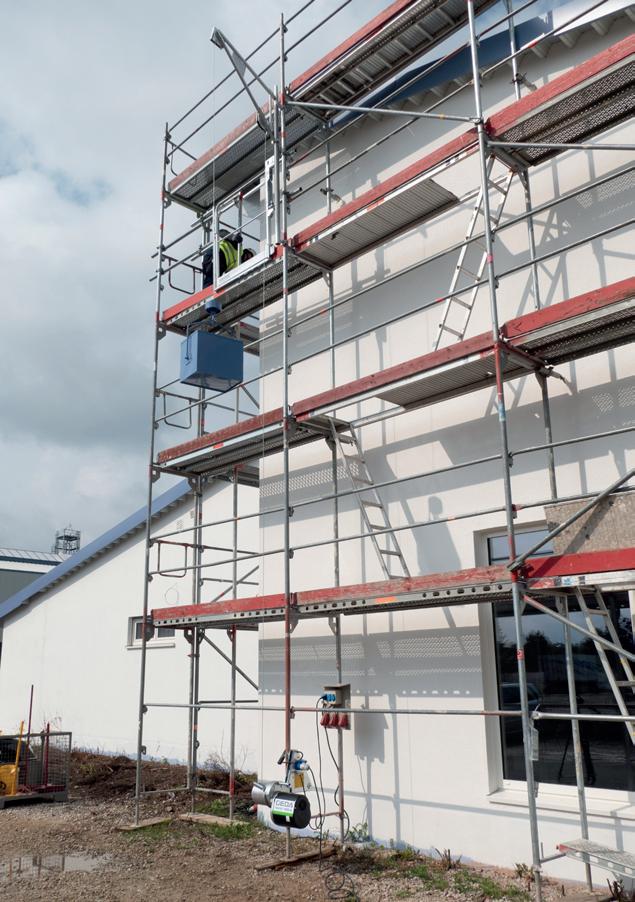

Your official sales partner in the UK:
Mace Industries Limitied
Units 1-3 Macadam Road
Earlstrees Industrial Estate Corby
Northamptionshire NN17 4JN
www.maceindustries.co.uk
+44 1536 206600
geda@maceindustries.co.uk


At the very heart of the scaffolding and access industry, ScaffMag has been serving the industry since 2009 by championing best practice, raising awareness of safety issues on-site and promoting business excellence.
ScaffMag delivers its mixture of news, views, trends and product updates through digital channels and in print.
ScaffMag gives businesses and brands an unrivalled opportunity to advertise their products or services 24 hours a day, seven days a week to a highly targeted audience.
To find out more about advertising, contact Jessica Norton on 01472 476024 or email jess@scaffmag.com